
COMFORT YOU
Livi.co.nz /livi-new-zealand DELIVERING SUSTAINABLE HYGIENE INFORMATION www.incleanmag.co.nz November 2022
QUALITY
CAN TRUST











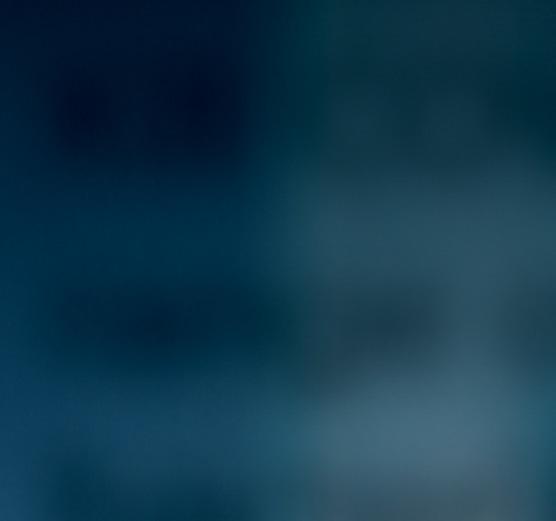



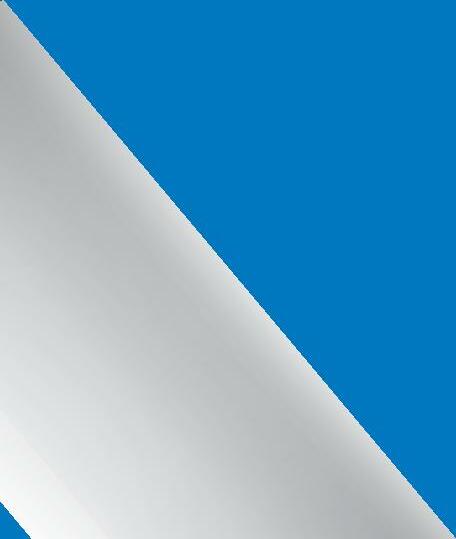






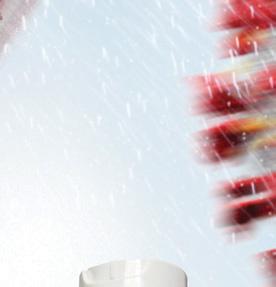


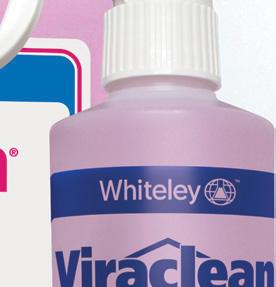









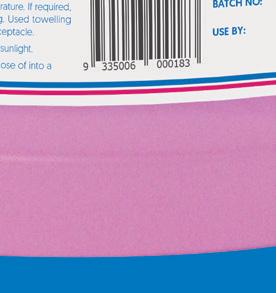

www.whiteley.co.nz
INCLEAN NZ is owned by ISSA
ABN: 44 617 407 020
P: +61 2 9890 4951
A: Suite 1, Level 1, 52 O’Connell Street, Parramatta, NSW, 2150 W: www.issa.com
DISCLAIMER: This publication is published by The Intermedia Group Ltd (the “Publisher”). Materials in this publication have been created by a variety of different entities and, to the extent permitted by law, the Publisher accepts no liability for materials created by others. All materials should be considered protected by New Zealand and international intellectual property laws. Unless you are authorised by law or the copyright owner to do so, you may not copy any of the materials. The mention of a product or service, person or company in this publication does not indicate the Publisher’s endorsement. The views expressed in this publication do not necessarily represent the opinion of the Publisher, its agents, company officers or employees. Any use of the information contained in this publication is at the sole risk of the person using that information. The user should make independent enquiries as to the accuracy of the information before relying on that information. All express or implied terms, conditions, warranties, statements, assurances and representations in relation to the Publisher, its publications and its services are expressly excluded. To the extent permitted by law, the Publisher will not be liable for any damages including special, exemplary, punitive or consequential damages (including but not limited to economic loss or loss of profit or revenue or loss of opportunity) or indirect loss or damage of any kind arising in contract, tort or otherwise, even if advised of the possibility of such loss of profits or damages. While we use our best endeavours to ensure accuracy of the materials we create, to the extent permitted by law, the Publisher excludes all liability for loss resulting from any inaccuracies or false or misleading statements that may appear in this publication.
Copyright © 2022 - The Intermedia Group Ltd
Editor’s letter
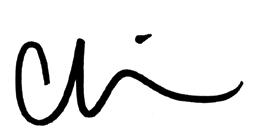
After more than three years in the making, CleanNZ Expo returned to Auckland in October, providing two-days of education, networking, and business building.
The free-to-attend event took place at the Ellerslie Events Centre on Tuesday 25 October and Wednesday 25 October, with more than 35 exhibitors showcasing the latest innovative products from local and international brands.
Running alongside CleanNZ Expo was the Building Service Contractors of New Zealand’s (BSCNZ) industry conference, Evolve, which hosted a high calibre of keynote speakers including Sir Richard Hadlee and Sir Ian Taylor. Check out our exclusive coverage of both events from page 18.
Also in this issue, our sustainability feature examines how cleaning industry operators across New Zealand are engaging in a raft of sustainable projects and initiatives which are helping their people and the environment, while also delivering efficiency benefits for their businesses and customers.
Other highlights in this edition include how to be prepared and respond to disaster recovery restoration, tips for conducting a product audit, as well as practical pointers for helping strengthen your marketing strategies.
Finally, we would like to wish all our valued readers and contributors a happy holiday season! Thankyou for your ongoing support this year, and we look forward to bringing you the latest industry news in 2023.
If you have a news story that you would like us to cover, please get in touch at info@incleanmag.co.nz.

EDITOR’S LETTER
Happy
Claire Hibbit Managing Editor FOR MORE INDUSTRY NEWS FOLLOW US ON CHECK OUT WWW.INCLEANMAG.CO.NZ INCLEAN NZ is published by The Intermedia Group Pty Ltd on behalf of ISSA – The Worldwide Cleaning Industry Association. 41 Bridge Road, Glebe NSW 2037 Australia PUBLISHER: Simon Cooper MANAGING EDITOR: Claire Hibbit E: chibbit@incleanmag.com.au P: +61 2 8586 6140 ADVERTISING MANAGER: Samantha Ewart E: sewart@incleanmag.com.au P: +61 2 8586 6106 PRODUCTION MANAGER: Jacqui Cooper PRODUCTION ASSISTANT: Natasha Jara GRAPHIC DESIGNER: Sanja Spuzanic NEW ZEALAND SUBSCRIPTION RATE: 12 months (4 issues) – NZD $44.00 (inc GST) To subscribe call +61 1800 651 422 E: subscriptions@intermedia.com.au
reading,
www.incleanmag.co.nz 3
What’s on
2022
Interclean China
23-24 November 2022
The international trade show will be staged in Hangzhou https://www.intercleanshow.com/china/


2023
The Cleaning Show
14-16 March 2023
The longest running dedicated event for the UK cleaning industry www.cleaningshow.co.uk/london
ISSA Pulire – The Smart Show
9-11 May 2023
The largest professional cleaning and sanitisation industry trade show in Italy www.issapulire.com/en/
ISSA Show Canada
14-15 June 2023
Canada’s leading trade show and conference www.issa.com

CMS Berlin
19-22 September 2023

The international conference and trade show will be held in Berlin www.cms-berlin.de
ISSA Cleaning & Hygiene Expo 1-2 November 2023
The ISSA Cleaning & Hygiene Expo will take place in Melbourne www.issacleaninghygieneexpo.com


ISSA Show North America
13-16 November 2023
Vegas to play host to the 2023 ISSA North America www.issa.com
2024
Interclean Amsterdam
14- 17 May 2024


The world’s leading trade show for cleaning and hygiene professionals. www.intercleanshow.com/amsterdam/

MOST CLICKED

www.incleanmag.co.nz
ISSA Cleaning & Hygiene Expo reports record attendance ISSA Cleaning & Hygiene Expo reports 25 per cent increase in attendees.



RapidClean announces most successful year to-date Rapid Group NZ records more than 20 per cent growth.
Bunzl ANZ to move into 6-star GreenStar-rated headquarters Bunzl ANZ announces science-based commitment to be net zero by 2030.
RCP releases sustainability vision roadmap
RCP launches brand sustainability roadmap outlining global pledges.
City of Melbourne calls on facility managers to help achieve net zero goals
City of Melbourne urges FMs, building owners, and industry associates to transform and retrofit CBD buildings to reduce their carbon emissions.
New hygiene and health survey identifies largest threats to future of wellbeing
Poor hygiene standards in public spaces among top concerns, study finds.
ON THE COVER
Livi products will help ensure hygiene is maintained to protect the health of your staff and residents. Livi paper products are PEFC certified meaning you can be confident that products are sourced sustainably, this certification also extends to safe, ethical and socially responsible work practices, both locally and via our global supply chains.

QUALITY COMFORT YOU CAN TRUST Livi.co.nz /livi-new-zealand www.incleanmag.co.nz November 2022
4 INCLEAN NEW ZEALAND November 2022


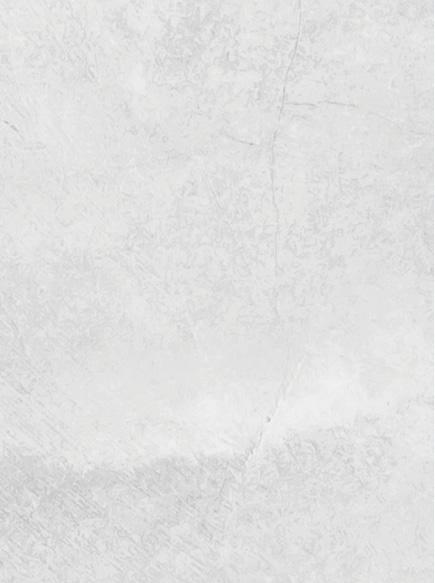










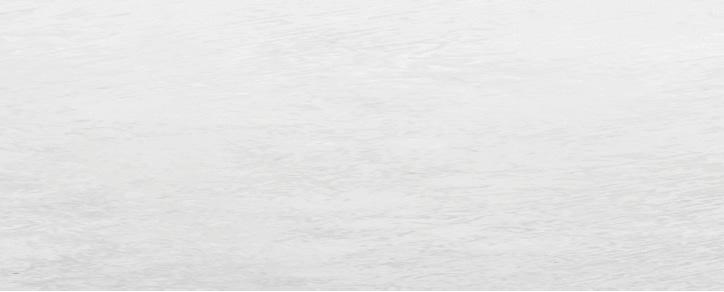








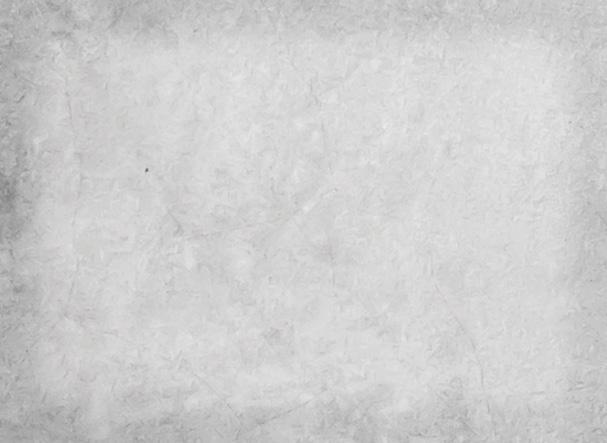




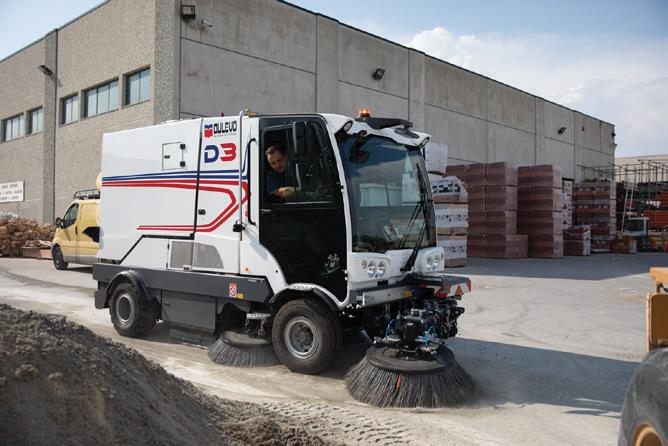





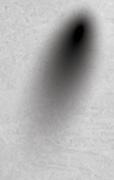




www.cleaningsupplies.net.nz Industrial/commercial scrubbers and sweepers are available for hire. Short and Long term hire options are available. PLUS Hire www.cleaningsupplies.net.nz 0800 2NZCLEAN Industrial/Commercial Scrubbers Hire Industrial/Commercial Sweepers Hire Long & Short Term Hire
18 CleanNZ Expo
Highlights from the long-awaited CleanNZ in Auckland 22 Protecting the elderly in the age of COVID-19
Stopping the next wave of infections in aged care facilities 26 Making a difference
How cleaning operators are helping people and the environment with sustainable initiatives 30 Disaster-recovery restoration –how to be prepared and respond Why knowledge and training has never been more important 34 How to conduct a product audit











A product audit can help simplify and streamline purchasing 36 Office spaces: Is your business set up to protect people from germs?




















Best practice tips for cleaning commercial office spaces 38 Cleaning up the innovation process with ideas testing
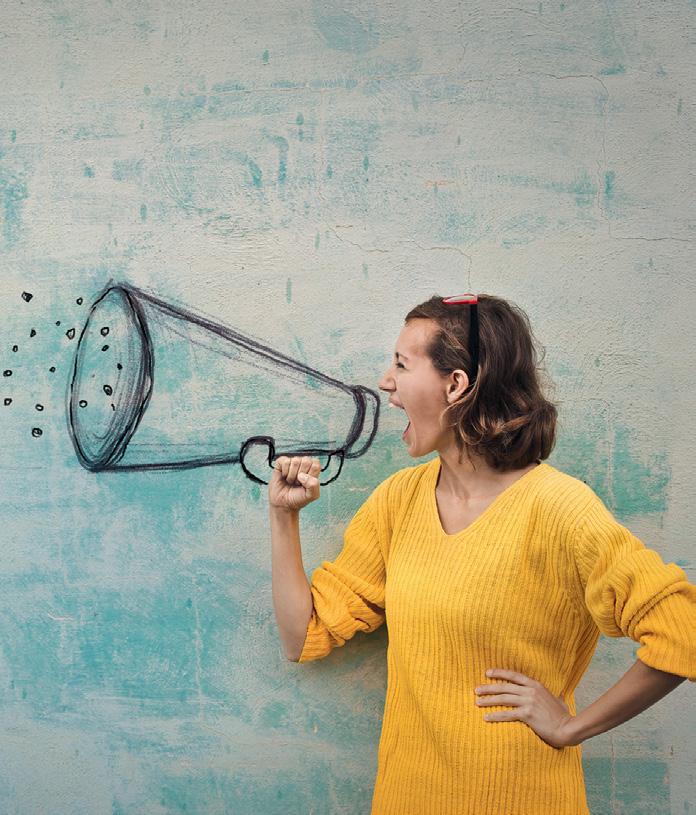
How innovation testing can help developers put their best product forward 40 The 7Ms of better marketing

Why it might be time to take a new approach to your marketing 44 Seven steps of carpet cleaning
Seven steps to ensuring commercial carpets are properly professionally clean
18 26 Regulars 03 Editor’s letter 12 Industry news 16 Cover story 44 Opinion 45 Products 40 30 IN THIS ISSUE NOVEMBER 2022 ISSUE #4 6 INCLEAN NEW ZEALAND November 2022


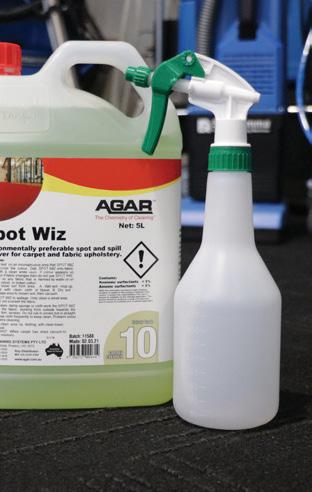




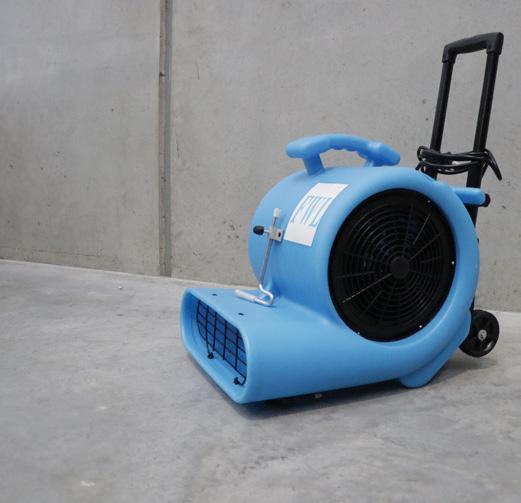

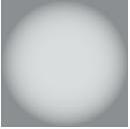

1 Preclean 2 Apply Treatment to Stains 3 Pre-Spray Main Carpet Areas 4 Rinse With Water Elevated Temperature 5 Agitate Carpet with Power Brush 6 Extract 7 Facilitate Carpet Drying The 7 Steps to Carpet Cleaning Success Clean Carpets with Confidence The best, high performance range of carpet cleaners, the most comprehensive local knowledge, and the best range of industry-leading chemicals – that's what you get with Proquip. To find out more about our range of high-performance carpet cleaning machines and chemicals talk to our friendly team at Proquip today! 0800 277 678 proquipnz.co.nz Scan here to learn more about The 7 Steps to Carpet Cleaning Success Check out our full range
Future-proof your business by embracing new sustainable cleaning solutions

Driven by market demand the cleaning industry is undergoing a significant shift towards sustainability to future-proof the businesses.
While this might mean adopting new procedures or investing in new technology, companies that embrace these solutions get better productivity, save labour, reduce costs over time and develop an innovative and socially responsible outlook.
NXP have been working with our manufacturing partners to source a range of exclusive and unique products to help you implement sustainable cleaning solutions and nd savings while doing it.
Our sustainable cleaning initiatives are helping our clients achieve these goals through:
•Solutions that avoid the usage of harsh chemicals
•Products that are recycled and have a longer life
•Eco-friendly chemical products
Tersano’s Stabilised Aqueous Ozone
Stabilized Aqueous Ozone (SAO) from Tersano is a highly e ective cleaning agent that turns regular water and oxygen into a powerful cleaner that breaks down dirt, grease and other contaminants. In fact, SAO exceeds Green Seal Standards (GS-37 and GS-53) as industrial cleaner.
e wall-mounted SAO Dispenser is a simple and sustainable way to clean, sanitize and deodorize everyday surfaces. Tersano's solution safely replaces traditional chemical cleaners, deodorizers & sanitizers and converts back to tap water & oxygen.
It's incredibly safe. On-site generation eliminates transport, storing and mixing cleaning chemicals. And when the job is done, it reverts back to water and oxygen with zero impact to our planet and waterways.
AVOIDING HARSH CHEMICALS
In a business and industrial setting, keeping your site hygienically clean has traditionally meant using harsh chemicals to achieve the desired result. However, new sustainable innovations are having a positive impact on cleanliness and the bottom line, while still meeting sustainability objectives.
Look for green cleaning products that don’t contain hazardous chemicals, pose fewer health risks and are less hazardous to the environment such as Tersano’s Stabilised Aqueous Ozone (SAO), Care4 Environmental Choice certi ed chemicals or the water based cleaning-desinfectatnts from DuroKleen.
SAO dispenser safely replaces traditional chemical cleaners, deodorizers & sanitizers, exceeding Green Seal Standards (GS-37 and GS-53) as industrial cleaner.

SPONSORED 8 INCLEAN NEW ZEALAND November 2022
Tersano’s
Care4
e Care4 rage provides extremely e ective cleaning, while still achieving Environmental Choice certi cation. It utilises the very latest surfactant technology and is very concentrated reducing storage costs.

e Care4 range of unique and innovative products are designed to make cleaning easier and quicker than other products and to be cost e ective in use avoiding ‘green premium’. And, because its developed and manufactured here in New Zealand its continually available and reduces transportation and emission costs.
Show That Your Business Cares About Sustainability | 100% ECNZ certi ed, the Care4 product range is kind to the planet without compromising on e ectiveness.
DuroKleen and DuroPax

ese New Zealand-made products use no harsh chemicals like alcohol, formaldehyde, or chlorine. ey are water based, non- ammable, skin friendly and environmentally friendly.
DuroKleen
DuroKleen is the hospital-grade disinfectant you need to keep surfaces safe for up to 30 days. DuroKleen disinfectants kill microbes on contact, forming a bond with the molecular structure of treated surfaces to create a biostatic barrier that prevents the growth of moulds, mildew, fungus, algae and bacteria.
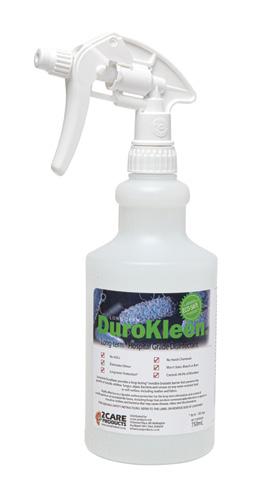


Duropax
Duropax actively cleans surfaces while deodoris ing and providing a disinfecting anti-microbial layer that provides up to 48 hours protection. It’s perfect for regular daily use in hight tra c environments like public transportation, public spaces and furniture in high-tra c areas where cleanliness is key.


Once dry DuroKleen forms a positively charged biostatic barrier
e barrier pierces the microbes protective layer causing it to die
Provides ongoing protection for up to 30 days
SPONSORED
Water based, long lasting antibacterial cleaing solution made in New Zealand
New Zealand Made
www.incleanmag.co.nz 9
How Durokleen works:
LONGER LIFESPAN OR CIRCULAR PRODUCTION
In a circular economy the plan is that products and their materials have the longest possible life cycle while retaining the maximum value.
Cleaning products with an exceptionally long service life can be used again and again, potentially saving both money and emissions by avoiding the need to replace the product more frequently. An even better outcome is when a er use a product is recycled, and the resulting raw materials are used again to manufacture a new product.
Greenspeed
Greenspeed’s 5 pillars of circular production are: use of non-toxic materials, design with reusable or degradable materials, use of renewable energy, responsible water use and socially responsible production.
Re-Belle
Re-belle is a fully circular micro bre cloth. It is 100% recycled and 100% recyclable and is the World’s rst circular micro bre that is Cradle to Cradle Certi ed® Bronze. Re-belle also has high cleaning power, a high absorption capacity and a long service life. anks to the high-quality micro bre material, surfaces are cleaned e ciently with a minimum amount of water.

C-Shuttle

e C‐Shuttle is an innovative cleaning trolley with a modular design for e cient cleaning. e cleaning trolley is convenient to use, light and easy to steer ‐ even when carrying a load of up to 200 kg. e cleaning trolley can be closed locked and o ers a range of handy storage options. e cleaning trolley is made of recycled materials (> 90% recycled plastic) and it is recyclable.
ECO FRIENDLY PRODUCTS
Will & Able

Will&Able supplies high quality NZ made eco-friendly cleaning products. All products are certi ed through ECNZ, vegan and not tested on animals. e product is packed in containers made from recycled NZ milk bottles and is lled and packed by people with disabilities. Will&Able also close the loop by taking empty containers back, washing them and reusing them.
With NXP you have access the most advanced cleaning innova tions available in New Zealand. To discover NXP’s full sustainable products range, ask about training or product demonstrations, email NXP’s Facilities expert team at facilities@nxp.nz
You can access NXP’s innovation catalogue here: https://tinyurl.com/nxpnz
Greenspeed’s C-Shuttle 150 and Re-Belle micro ber cloths.
Support Will&Able’s mission to create 100 new jobs for Kiwi's with disabilities and make earth-friendly cleaning products.
SPONSORED
Heritage, Quality, Innovation

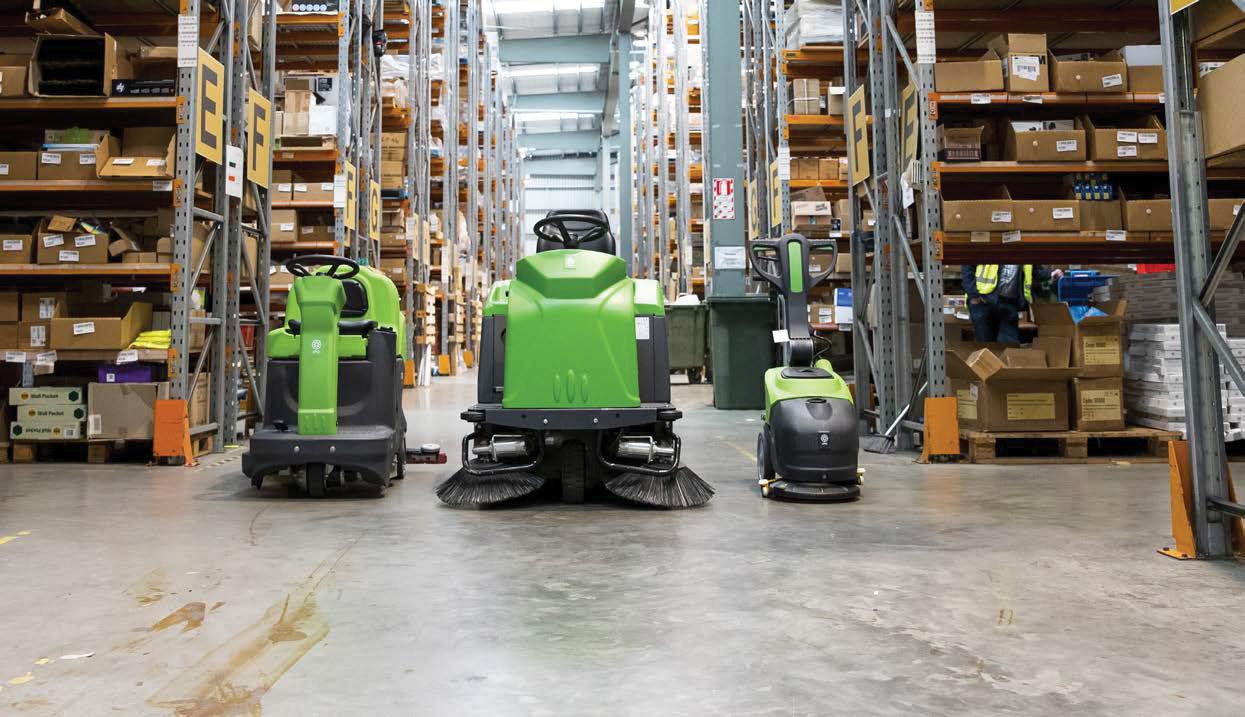



Get in touch: facilities@nxp.nz www.nxp.nz Robotic cleaning innovation Minimal downtime for cleaning machines Cleaning machines to cover every category 150 years of experience
Tennant is a world leader in creating and supplying industrial-grade cleaning machines which work to make the world a cleaner, healthier place. Available now through NXP: › Scrubbers › Sweepers › Scrubber-dryers
IPC: Always Seeking Innovation Under the Tennant umbrella but with its own proud history of innovation, IPC offers accessible, high quality cleaning machinery for the modern cleaning professional.
2022 ISSA Cleaning & Hygiene Expo reports record attendance in Sydney
The much-anticipated ISSA Cleaning & Hygiene Expo made its return to Sydney in September, with the event reporting record attendance.
Held at the International Convention Centre, (ICC) in Sydney, the show reported a 25 per cent increase in ISSA Cleaning & Hygiene Expo attendees.



“We heard from many visitors and exhibitors that ‘this was the best show to date’ and the momentum for this event was high from the start,” said Lauren Micallef, ISSA Oceania manager.
“Our pre-registration numbers were up 58 per cent against our last expo, with many members commenting on the ‘buzz’ they were hearing throughout the industry.”
This year saw the largest overseas attendee representation with more than 20 countries represented, including France, Germany, Japan, Singapore, South Korea, New Zealand, United Kingdom, USA, and more.
“It was also exciting to see the growth in attendees from across all states and territories in Australia. All making the trip to be part of the only show in
Australian dedicated to the cleaning and hygiene industry.”
With almost 40 per cent of visitors stating that their primary reason for attending the show was to expand business networks and meet new suppliers, the expo did not fail to deliver with more than 88 of the country’s leading exhibitors, the largest number to date, present on the show floor.
Stuart Nicol, ISSA Advisory Council Chair, said it was terrific to see the continual support that the ISSA Cleaning and Hygiene Expo is receiving and the that the industry is getting behind the show.
“We saw returning exhibitors, as well as a number of companies that hadn’t exhibited for a long time, not to mention new players.”
The speaker theatre showcased more than 40 industry thought leaders sharing their expertise and knowledge across a variety of industry topics.
Gareth Marriott, Managing Director, OCS Australia and New Zealand, said it was great to see the industry come together again.

“There was so much positive feedback after being in lockdown for such a long
period of time,” said Marriott.
Micallef said the environment was energised by the efforts of the speakers, workshops, attendees, sponsors, and exhibitors many of whom had taken up bigger and grander stands, had interactive product demonstrations and as well as new product launches.
“Our speaker session with Michael O’Loughlin drew in a large crowd with the audience wanting to uncover more information about what to look for and why to invest in indigenous services,” said Adam Mercer, Director – Business Development, ARA Indigenous Services.
This year companies also took the opportunity to bring their team’s and run events either side of the expo to maximise their experience.
“RapidClean held our annual conference in conjunction with the ISSA show as this enabled our store owners, throughout Australia and New Zealand, to attend the workshops and see the new and innovative products being exhibited. They then take the knowledge that they gained back to their customers,” said Bruce Lees, General Manager ANZ, Rapid Group.
12 INCLEAN NEW ZEALAND November 2022 INDUSTRY NEWS
INCLEAN EXCELLENCE AWARDS
The highly anticipated 2022 INCLEAN Excellence Awards were also announced following the conclusion of the first day.
This year the awards received a record number of entries across six innovation categories including Large Equipment, Small Equipment, Services & Technology, Chemical Agents, Paper and Dispensing, and Janitorial Items.
Winners included Sprintus ERA PRO, Cleanstar (Innovation EquipmentSmall); Scrubber 50 Pro, Gausium (Innovation Equipment – Large); Sorbent Professional 25100 2ply Embossed Jumbo Roll Toilet Tissue 250 metres, Solaris Paper (Paper & Dispensing) Doxall, Ten Carbon Chemistry (Innovation Cleaning Agents); Hako Dust Stop, Hako Australia (Innovation Services & Technology); i-matt, i-team ANZ (Innovation Janitorial).
“Our team was chuffed to win as it’s been a tough few years,” explains Michelle Hood, Commercial Strategy and Marketing Manager, Solaris Paper, “but to receive independent positive affirmation has been very rewarding.”
“Also, [winning the award] brings with it great publicity.” According to Dr Tony Peacock, Chairman of Ten Carbon Chemistry, “the spotlight from the INCLEAN Excellence Award is actually very intense and we’ve had a great reaction both at the expo and in the following weeks”. Day two concluded with networking drinks hosted by ISSA.
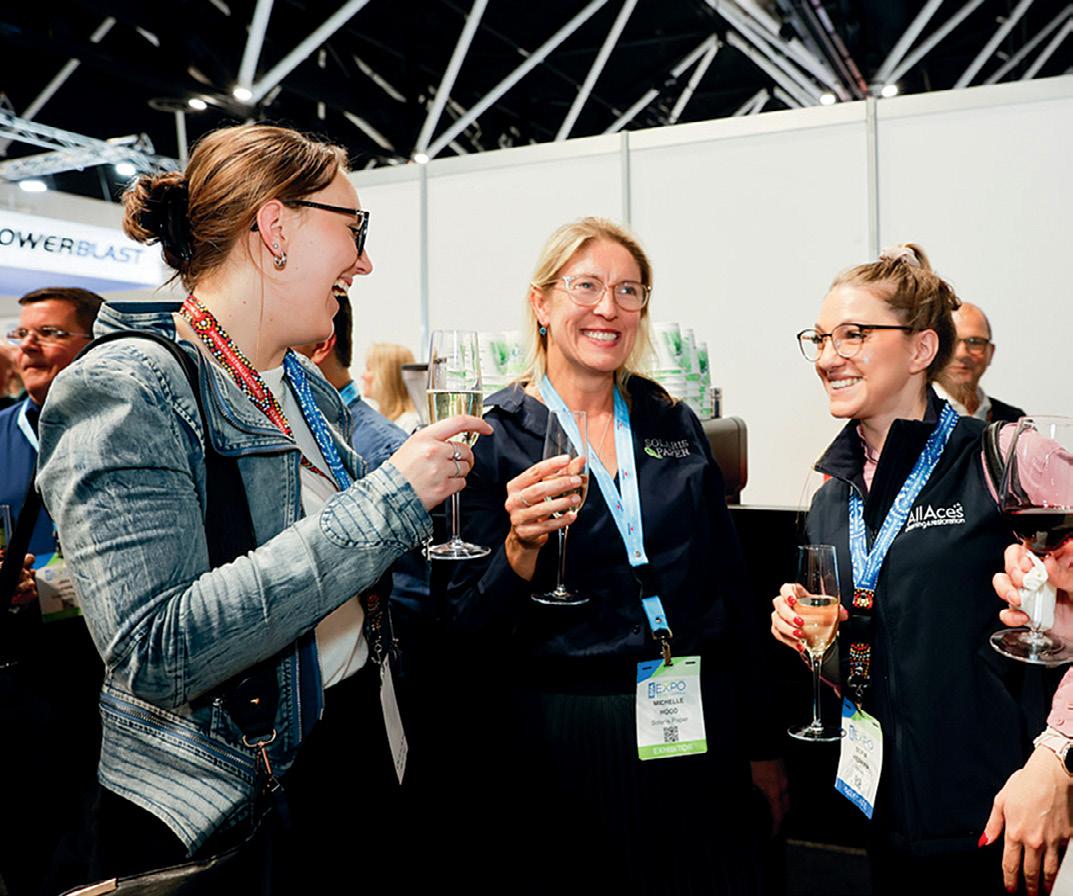
“This was the best show by far! If you didn’t make it to the ISSA Cleaning & Hygiene Expo this year, we are sorry you missed out, but we hope to see you next year!” commented Greg Whiteley, Executive Chairman, Whiteley Corp.



“ We heard from many visitors and exhibitors that ‘this was the best show to date’ and the momentum for this event was high from the start.
”
www.incleanmag.co.nz 13 INDUSTRY NEWS
Lauren Micallef, ISSA Oceania Manager
Livi products will help you ensure hygiene is maintained to protect the health of your staff and residents.



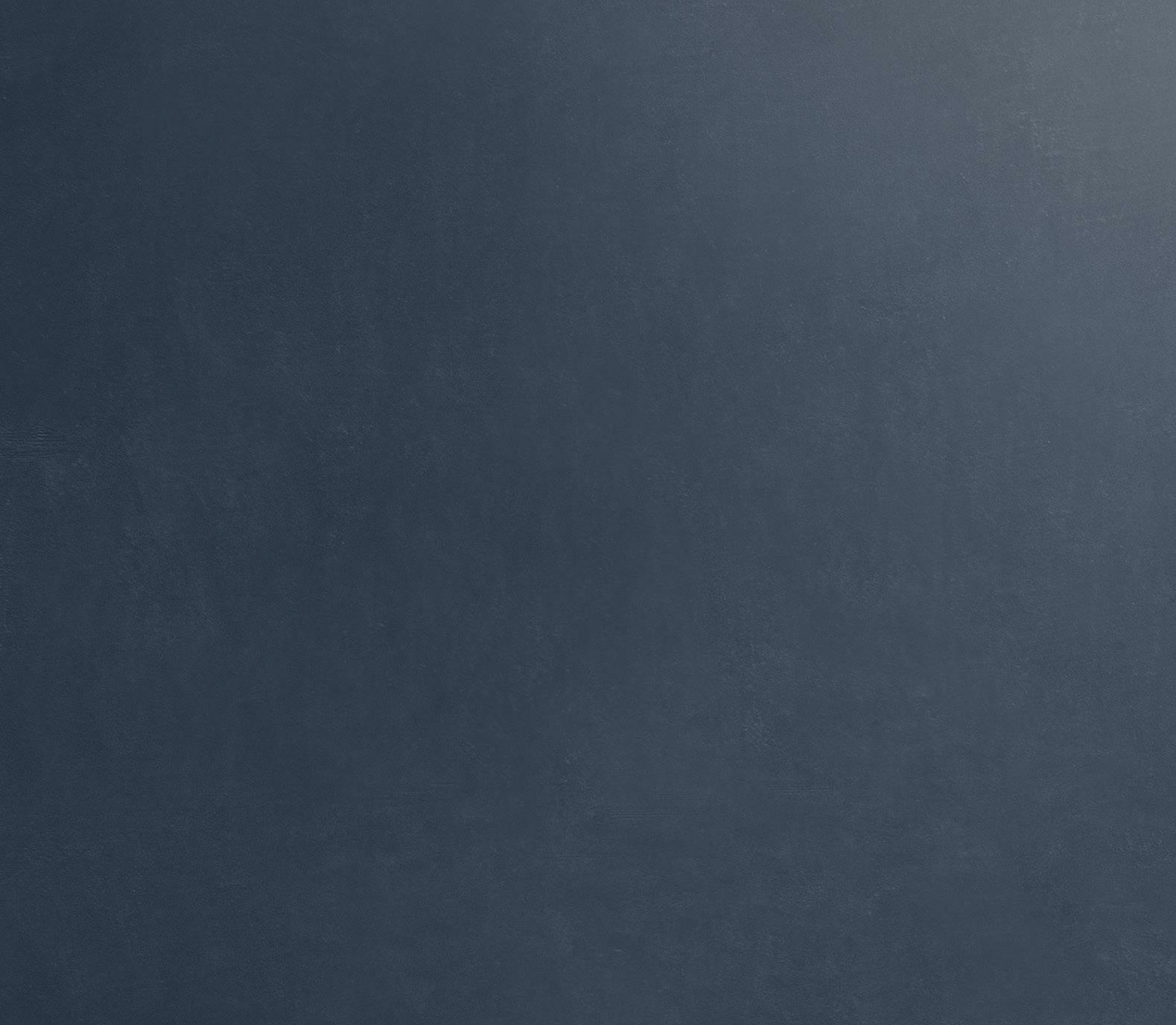

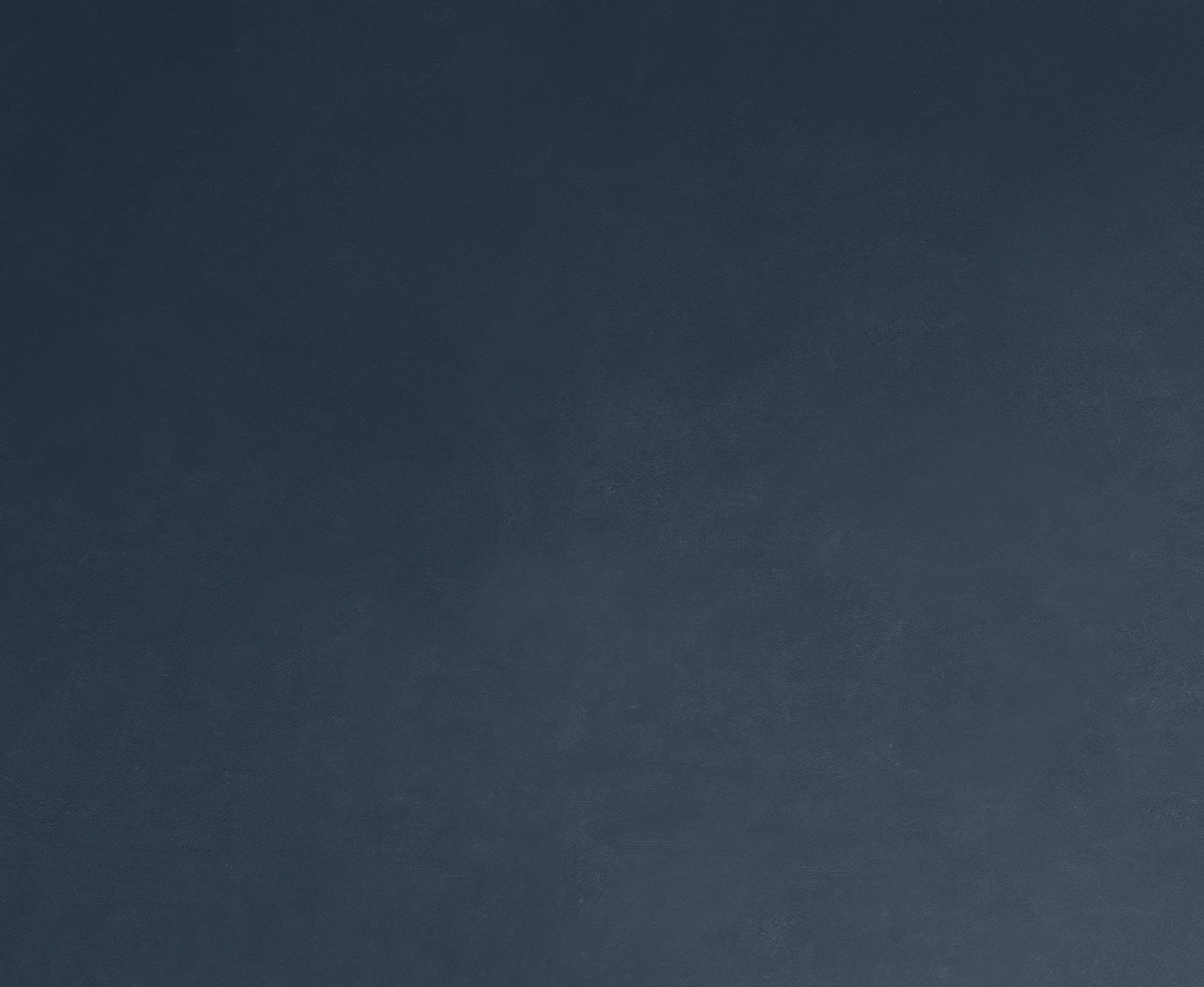


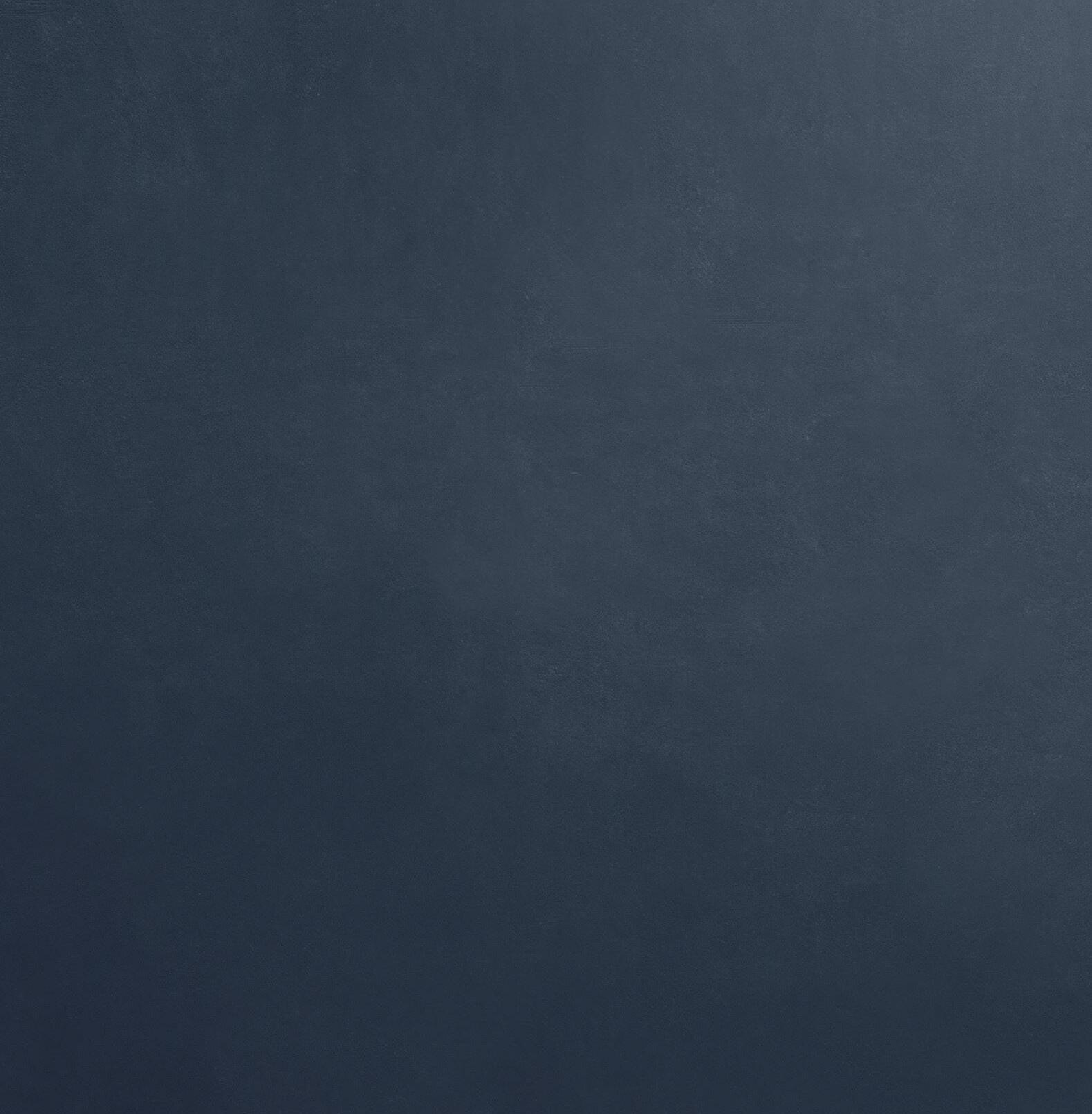



Livi paper products are PEFC certified meaning you can be confident that our products are sourced sustainably, this certification also extends to safe, ethical and socially responsible work practices, both locally and via our global supply chains.
•
• PEFC Certified products
The Livi team are here to partner with you to bring the best paper hygiene solutions for your business. • Improving Hygeine
Partnering with you for all your paper and hygiene solutions
your partner
PEFC certified This tissue product is from sustainably managed forest and controlled resources www.pefc.org
in paper and hygiene solutions













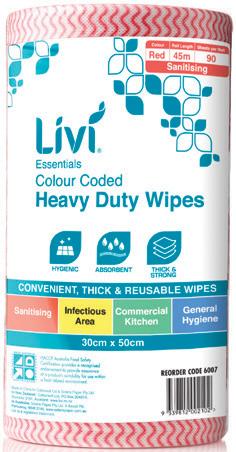






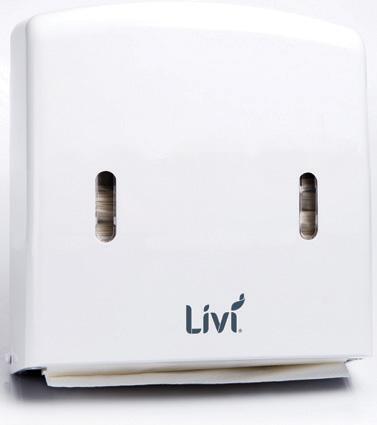




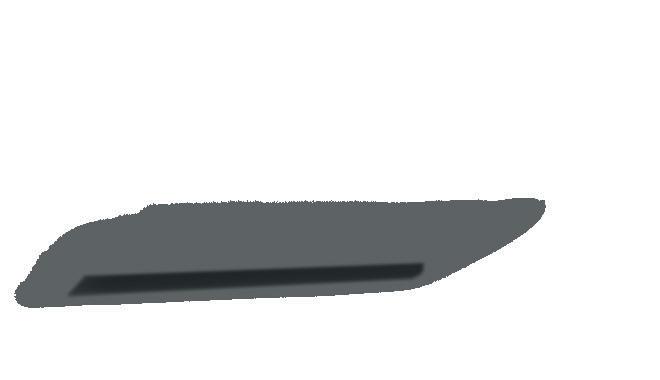



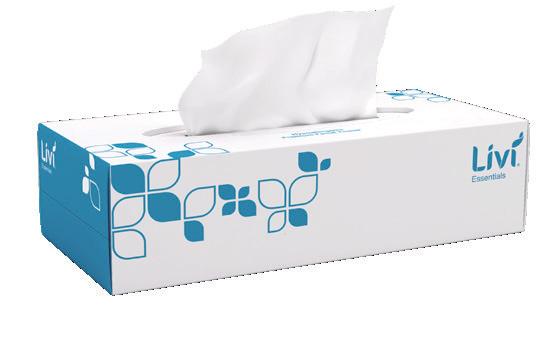



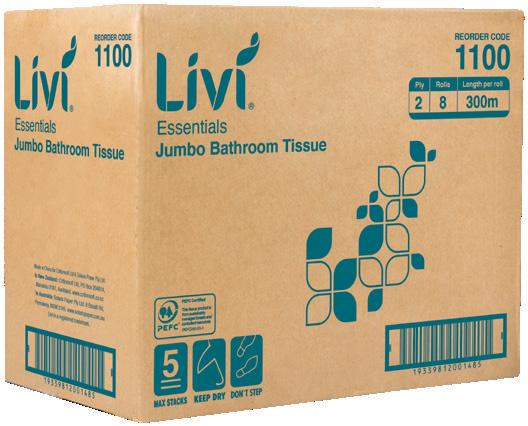












Strong, Super absorbent, reusable cleaning cloth wipes – Eliminate cross contamination and improve hygiene standards with our convenient colour coded cloth wipes. • Strong, absorbent and reusable • Lightweight & hygienically sealed pack • Colour coded system to prevent cross contamination • HACCP endorsed for safe food usage* • Added antibacterial additives for infectious control** BLUE: General Hygiene RED: Sanitising YELLOW: Infectious control Premium anti-bacterial wipe GREEN: Commercial Kitchen Contact your Territory Account Manager to discuss our full range of dispenser and hand towel options, or contact us on 0800 22 34 11 livi.co.nz /livi-new-zealand CLEANING *Excluding reorder code 6005 **Reorder code 6005 only We’re here to help you with smart hygiene solutions • 2ply hypo-allergenic tissues 100 or 200 sheets • PEFC Certified FACIAL TISSUES White, soft and absorbent, the Livi facial tissues look good on any desk or vanity. • 2ply and 3ply tissue • PEFC Certified TOILET TISSUE Our extensive range of premium and luxury toilet tissue includes single tissue rolls, interleave toilet paper and jumbo toilet rolls. Great quality 2ply towels offering softness & absorbency HAND TOWELS A complete offering of high impact dispensers to deliver all tissue products in a clean, simple design to match most decors. Livi dispensers help control usage and keep your facility tidy. All our tissue products are PEFC Certified. PUBLIC AREAS IN-ROOM
New floor care range coming soon to RapidClean NZ
RapidClean New Zealand has announced the expansion of its chemical range to include a new selection of floor care. The new products include solutions for both complete hard floor and carpet care, including: Carpet Plus – A Pre-spray Detergent (5-litre); Encase - Encapsulating Carpet Shampoo (5-litre); Spotty – Carpet & Upholstery Spotter (750ml); Carpet Fresh – Carpet & Upholstery Deodoriser & Cleaner (500ml); Quick Strip – Hard Floor Stripper (5L); Gloss Plus – Water Based Sealer Finish (5-litre); Quick Shine – Hard Floor Cleaner Maintainer (5-litre); and Tile Clean HD – Highly Concentrated Degreaser Detergent (5-litre).
Commenting on the new product range, RapidClean New Zealand Manager, Geoff Hughe, said: “We are proud to provide our customers with this innovative range, we continuously strive to meet all of our customers cleaning supply needs and we are confident these products will deliver exceptional cleaning results every time.”

The range includes cleaning solutions for carpet extraction, carpet shampooing, upholstery cleaning, deodorising and stripping and polishing hard floors to name a few.
RapidClean’s new floor care range will be available to purchase from all 13 RapidClean stores from November 2022.
While Foxcroft has more than 10 years’ of auditing experience, the accreditation provides a formal qualification that is highly regarded in the cleaning industry and will provide added reassurance to those using CrestClean’s services.
“The ISSA is a leader in cleaning qualifications and, as a corporate member, CrestClean is always kept up to date with the latest offerings. I could see a lot of

benefit and added value in completing the course,” said Foxcroft.
“We have a comprehensive auditing system at CrestClean, and the workshop confirmed that we’re doing everything right in terms of best practice. But, as with any system or process, there is always room for improvement, and I will be applying important learnings from the workshop to refine what we already have in place.”
CrestClean is the largest private trainer of cleaning personnel in New Zealand, hosting more than 200 training events each year through its Master Cleaners Training Institute (MCTI).
As head of MCTI, Foxcroft is responsible for developing and implementing CrestClean’s training programme, which includes keeping the company’s nationwide team of Quality Assurance coordinators up to date with the latest best practices in auditing.
International auditing achievement for CrestClean’s Liezl Foxcroft
CrestClean’s General Manager of Training Liezl Foxcroft has successfully completed the ISSA’s Cleaning Management Institute’s auditing training course.
16 INCLEAN NEW ZEALAND November 2022 INDUSTRY NEWS
& facial tissue with softness & quality that will leave a lasting impression.

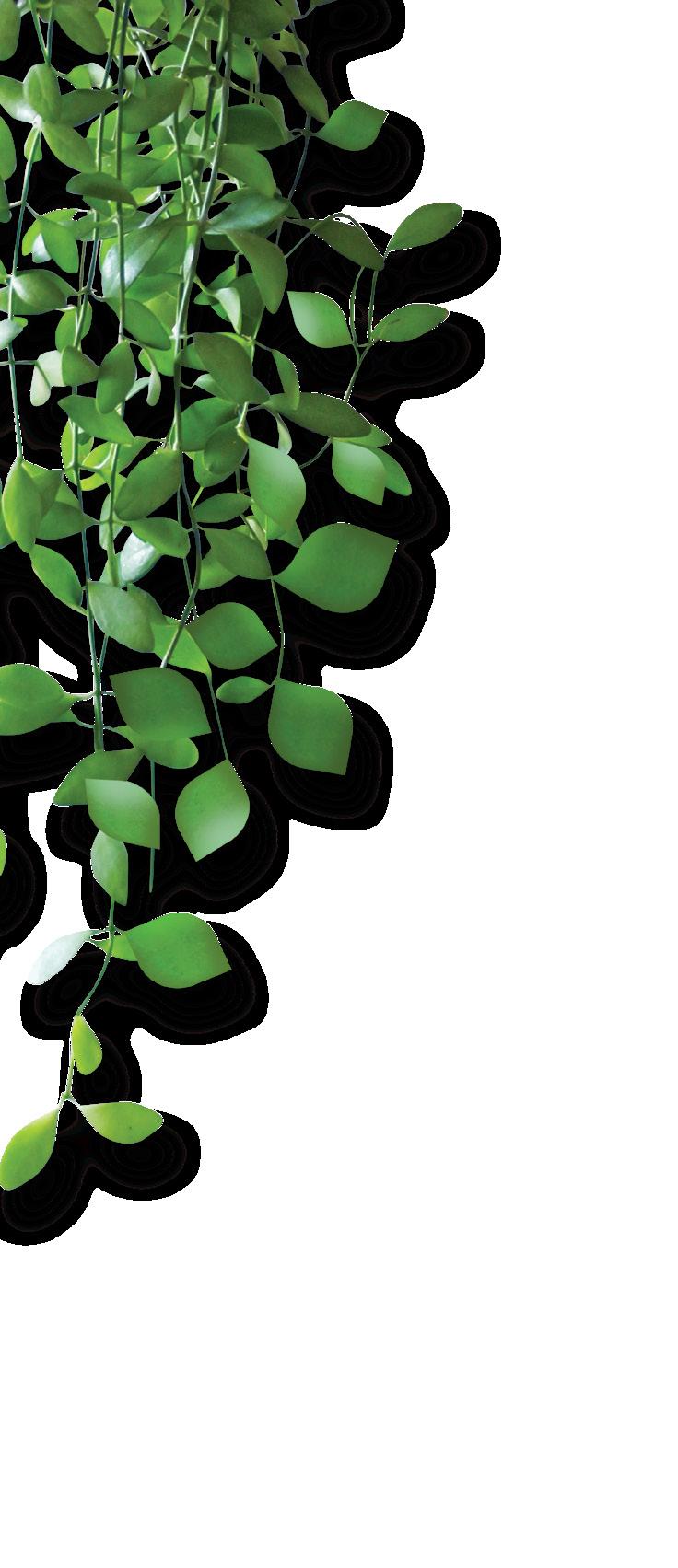

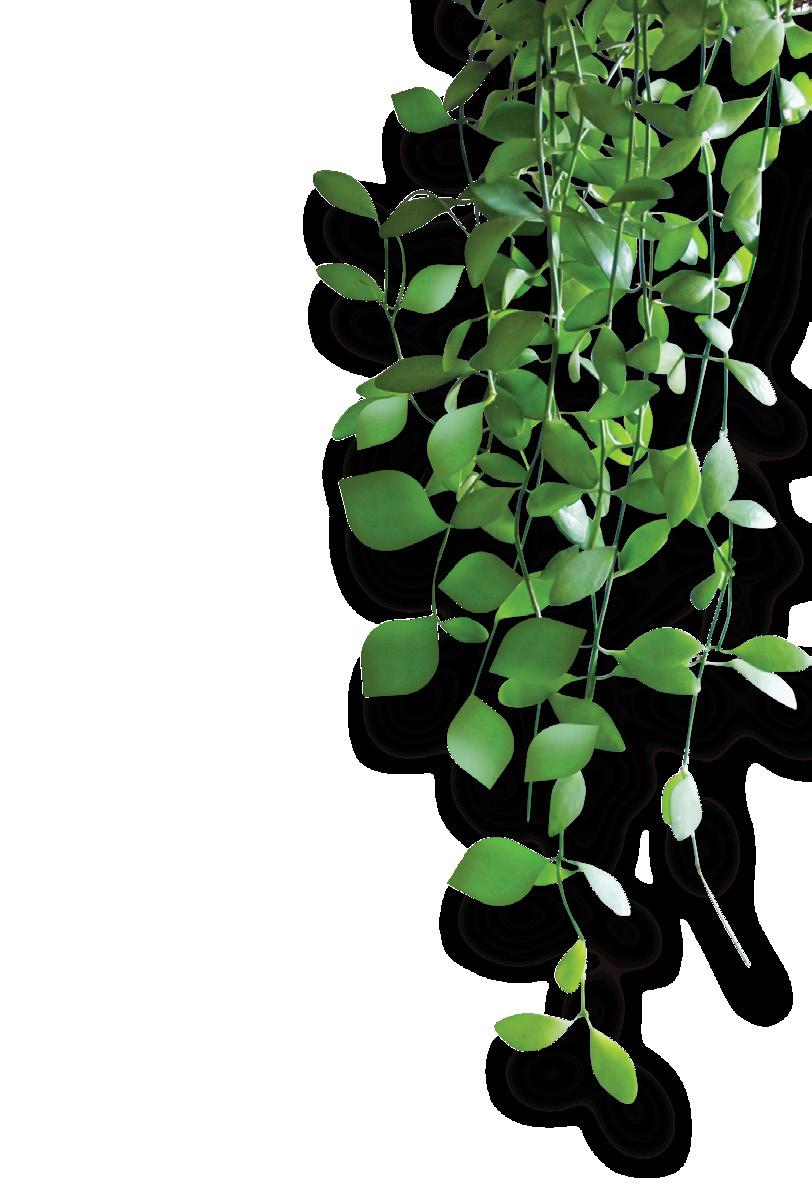







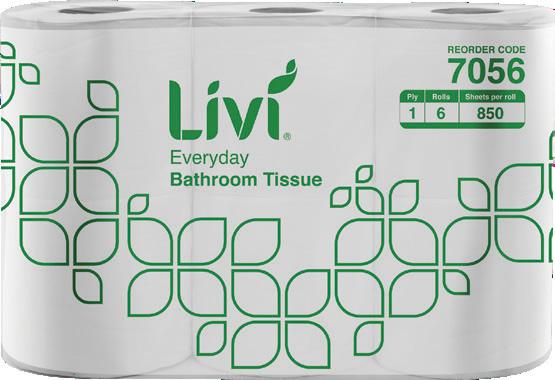
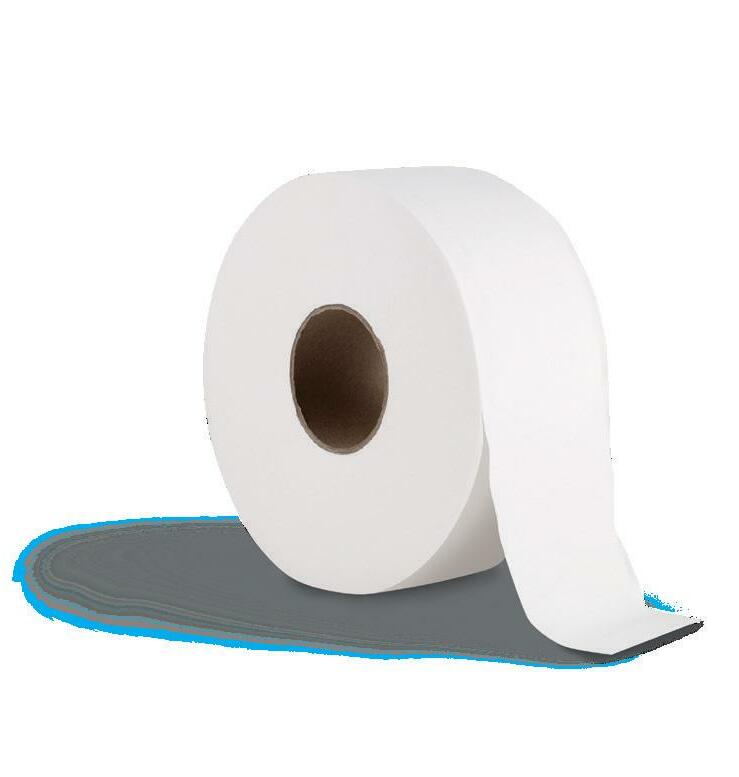






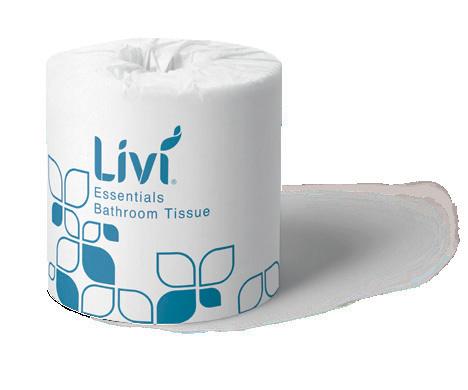






towels
Premium Economy A competitively priced range of toilet tissue & hand towels perfect for high volume facilities. A reliable & moderate range of toilet tissue, hand towel & facial tissue that is suitable for both high & low volume areas. Mid-range /livi-new-zealand Livi.co.nz /LiviNewZealand 0800 223 411 QUALITY COMFORT YOU CAN TRUST Do you know our retail brands?
An ultra-premium range of toilet tissue, hand
CleanNZ Expo
A look back at the long-waited CleanNZ Expo and Evolve Industry Conference.
CleanNZ Expo returned to Auckland in October, offering opportunities for networking, education, and product discovery for New Zealand’s commercial cleaning industry.

Hosted by the Building Service Contractors of New Zealand (BSCNZ) and organised by Interpoint Events, CleanNZ Expo is New Zealand’s only dedicated trade show and conference for the commercial cleaning industry.
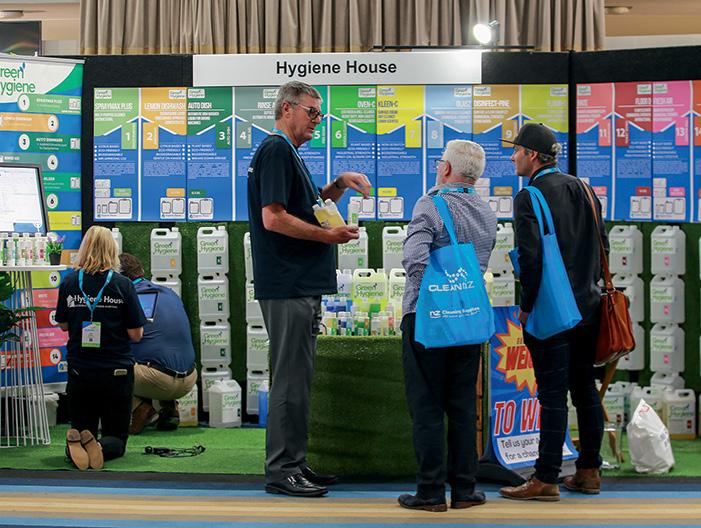


The free-to-attend event took place at the Ellerslie Events Centre on Tuesday 25 October and Wednesday 26 October, with more than 35 exhibitors showcasing cutting-edge products and new innovative cleaning solutions, and almost 1000 attendees.

Sarah McBride, CEO of the BSCNZ, said the aim of the event was to educate, motivate, and inspire success.
“CleanNZ Expo has been more than three years in the making and it was great to be able to reconnect with everyone and bring building service contractors, business owners, facilities managers, and suppliers, all back together again.”
Deane Rogers, National Account and Events Manager, Kärcher New Zealand, said CleanNZ Expo provided a platform to showcase new innovative products to the industry.
“Kärcher NZ is a regular exhibitor at CleanNZ Expo and sees it as a premier mechanism to support the industry, whilst using [the event] as a platform to showcase new and innovative products to the industry. And, we have many! We attained some great leads due to the thirst of the attendees who wanted innovative solutions.”
Ebin Sebastian, Managing Director of NZ Cleaning Supplies, said his team met with industry experts and gained insights on the latest innovations.
“We met with some potential suppliers and potential buyers that we are excited about,” he said.
Dallas Vincent, Director of Mode Robotics, said the event was “an absolute success” for Mode Robotics.
“It was our first time exhibiting and not only was it a great learning experience for our team, but also a really successful one, where we got some really big leads. I would highly recommended exhibiting and attending next event.”

Nick Garrety, Country Manager, Tennant NZ, said: “It was great to see the industry back together again face to face, with new relationships formed and others re-connected. The positivity around the industry was good to see and our new products were welcomed by the audience.”
Richard Murray, Whiteley NZ Sales Manager, said the conference was a highly valuable event for the Whiteley NZ team.
“It was a fantastic opportunity for the team to see the industry again. It was good to interact with customers who purchase and use our product range, and we were also able to speak with many BSCs that showed interest in our products.”
Geoff Hughes, National Manager, RapidClean NZ, which hosted its own industry conference following CleanNZ, said: “It was great to see customers and suppliers again after almost three years, and we received great feedback and inquiries about our new environmental product range that was launched at CleanNZ.”
The event also provided free education sessions for attendees, in partnership with registered training organisation, Careerforce, with topics focused on the latest trends and solutions for cleaning, as well as employment law, health and safety, and indoor air quality.
18 INCLEAN NEW ZEALAND November 2022 CLEANNZ EXPO







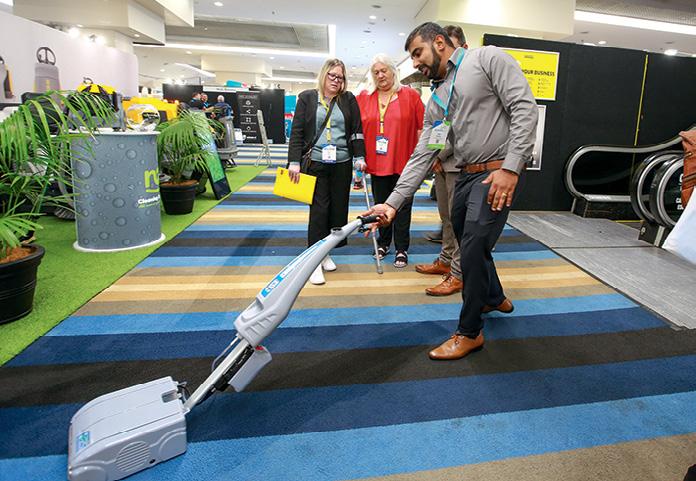




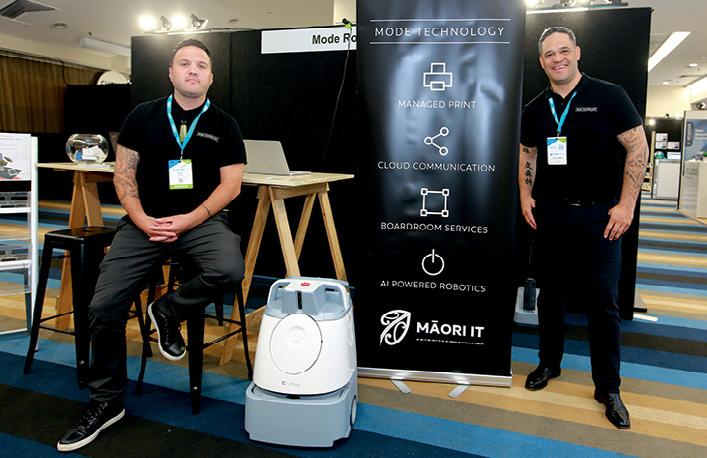
“
We attained some great leads due to the thirst of the attendees who wanted innovative solutions. ”
www.incleanmag.co.nz 19 CLEANNZ EXPO
Deane Rogers, Kärcher New Zealand
Speakers included Sean Johnson, Restore Cleaning Restoration; Penny Barrett, Careerforce; Rebecca Mitchell, Solutions Partner, ACC; Callum McMillan, MBIE; Wendy Stephens, Sappho Creative Solutions; and Karen Kavanagh, Rentokil Initial. For the first time, St Johns also hosted two-hour health and safety training sessions for delegates across both days of the expo.
EVOLVE INDUSTRY CONFERENCE
The BSCNZ also hosted its industry conference, Evolve, in conjunction with CleanNZ Expo. Hosted by media personality Kerre McIvor, the BSCNZ Evolve Industry Conference featured a host of high calibre speakers including Sir Richard Hadlee; Sir Ian Taylor; Kirk Hope, CEO of BusinessNZ; and ANZ chief economist, Sharon Zollner.
“Inspiration went beyond industry related topics,” said McBride of the impressive speaker line-up.
“The Evolve Industry Conference speakers exceeded expectations. Their content was educational, genuine, honest, and offered great insights. I know that everyone present was grateful for their contributions to our industry conference.”
Liz Spring, Southern Regional Manager, PPCS Facility Services, described the conference as a valuable team building experience for PPCS Facility Services.
“I brought my team from Wellington, and it was a great team building experience for everyone. There were also some critical takeaways for us as a business from the conference’s education sessions.”
Ian Kebbell, Managing Director of Supercare, said: “The Evolve conference
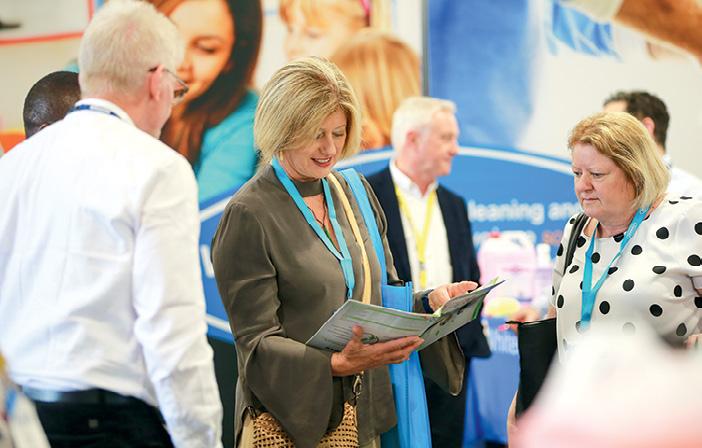



was an excellent event with world-class speakers. We had a fantastic line-up of high-profile presenters that spoke on a broad range of topics, and even though some were outside of our industry, they were still just as relevant.”

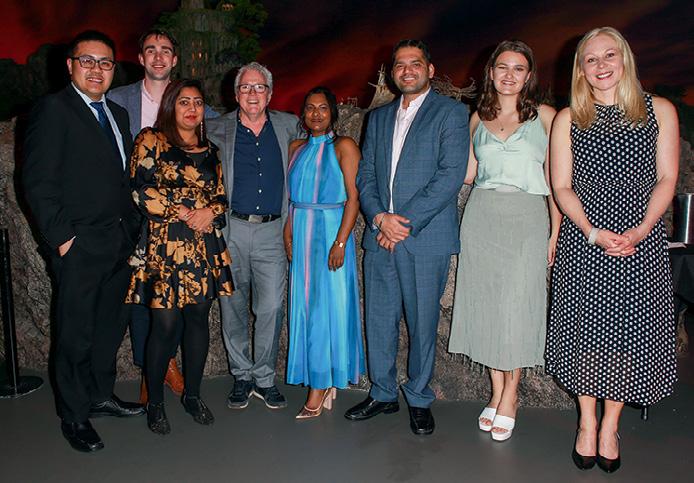

Evolve also featured dual networking event for BSCNZ and Facilities Management Association of New Zealand (FMANZ) members, sponsored by Tork Professional Hygiene, following the conclusion of the first day of the conference.


“Without our generous sponsors CleanNZ Expo and the BSCNZ Evolve Industry Conference would not be possible so a sincere since thank you to all, including our Gold Sponsors Auckland Unlimited and Karcher New Zealand; Silver Sponsors Bunzl, Kiwi Maintenance Group, and Mobil; and Bronze Sponsor, Filta,” said McBride.
“Special thanks also to Essity for sponsoring the FMANZ networking event and Qual Chem for sponsoring our keynote presentation from Sir Richard Hadlee. Without their support, this great industry event would not have been possible.”
CleanNZ and the Evolve conference concluded with a gala dinner held at Sky City sponsored by NZ Cleaning Supplies.

“
The Evolve Industry Conference speakers exceeded expectations. Their content was educational, genuine, honest, and offered great insights, ”
20 INCLEAN NEW ZEALAND November 2022 CLEANNZ EXPO
Sarah McBride, BSCNZ


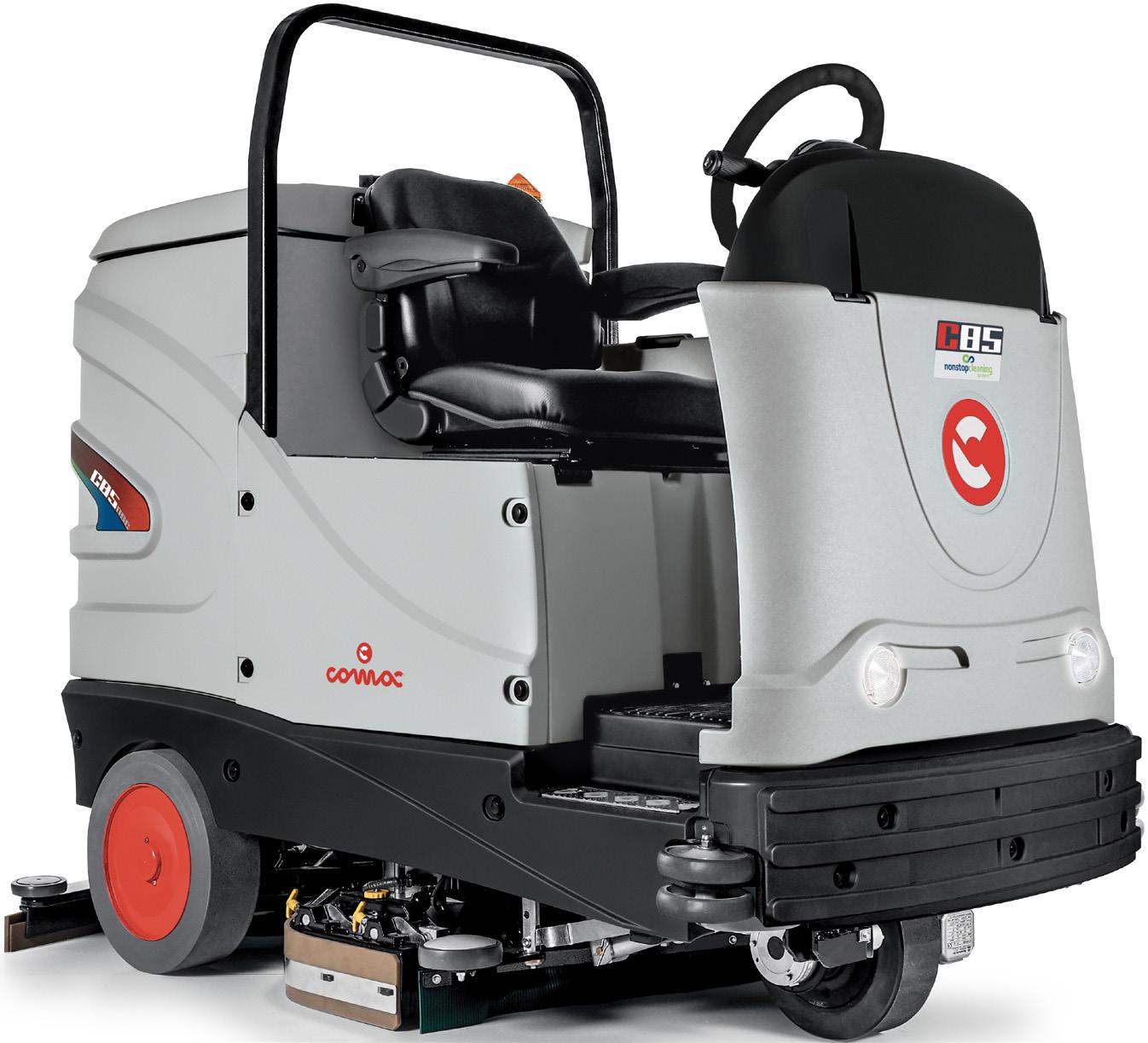
Filter water, faster
C85 NSC Water Recycling System referencia, y no están vinculadas al diseño y/o al equipamiento. COD. 302534AD 12/21 Copyright © COMAC 2021 scrubber dryer equipped with Non Stop Cleaning Premium system, not only reduces the unproductive loading and unloading times of the solution all, it saves up to 80% of water and 90% of chemical.
high economical advantage,
result. To save
WATER -80% CHEMICAL -90% PIT STOP TIME -85% WASTEWATER -85% a day, 5 days, with medium dirt grade, in Eco Mode. DESCRIPTION C85 NSC Base C85 BS NSC Base C85 B NSC Premium CS85 BS NSC Premium l/gal 300/79,2 300/79,2 300/79,2 300/79,2 The advantages of NSC 80% less water usage imágenes utilizadas son de simple referencia, y no están vinculadas al diseño y/o al equipamiento. COD. 302534 AD 12/21 Copyright © COMAC 2021 Comac C85 scrubber dryer
but, above
it saves up to 80% of water
cleaning operations
To save up to (1): WATER -80% CHEMICAL -90% PIT STOP TIME -85% WASTEWATER -85% (1) use 3h a day, 5 days, with medium dirt grade, in Eco Mode. TECHNICAL DESCRIPTION C85 NSC Base C85 BS NSC Base C85 B NSC Premium CS85 BS NSC Premium Tank capacity l/gal 300/79,2 300/79,2 300/79,2 300/79,2 Working width mm/inch 850/33,4 850/33,4 850/33,4 850/33,4 Squeegee width mm/inch 1105/43,5 1105/43,5 1105/43,5 1105/43,5 Moving scrubbing brush head mm/inch 150/5,9 150/5,9 Working width with side brush mm/inch 1000/39.3 1000/39.3 Working capacity up to sq.m/h/sqft/h 6800/73194.59 6800/73194.59 6800/73194.59 6800/73194.59 Autonomy h 4 4 4 4 The advantages of NSC 90% less chemicals usage de equipamiento. Las imágenes utilizadas son de simple referencia, y no están vinculadas al diseño y/o al equipamiento. COD. 302534 AD12/21Copyright © COMAC 2021 Comac C85 scrubber dryer equipped with Non Stop Cleaning Premium system, not only reduces the unproductive loading and unloading times of the solution but, above all, it saves up to 80% of water and 90% of chemical. This is an high economical advantage, that minimizes the environmental impact of floor cleaning operations without affecting the result. To save up to (1): WATER -80% CHEMICAL -90% PIT STOP TIME -85% WASTEWATER -85% (1) use 3h a day, 5 days, with medium dirt grade, in Eco Mode. TECHNICAL DESCRIPTION C85 NSC Base C85 BS NSC Base C85 B NSC Premium CS85 BS NSC Premium Tank capacity l/gal 300/79,2 300/79,2 300/79,2 300/79,2 Working width mm/inch 850/33,4 850/33,4 850/33,4 850/33,4 Squeegee width mm/inch 1105/43,5 1105/43,5 1105/43,5 1105/43,5 Moving scrubbing brush head mm/inch 150/5,9 150/5,9 Working width with side brush mm/inch 1000/39.3 1000/39.3 Working capacity up to sq.m/h/sqft/h 6800/73194.59 6800/73194.59 6800/73194.59 6800/73194.59 Autonomy h 4 4 4 4 Disc brush (n.) mm/inch (2) 430/17 (2) 430/17 Cylindircal brushes (n.) mm/inch (2) 210x856 (2) 8,2x33,7 (2) 210x856 (2) 8,2x33,7 Brush pressure Kg/lbs 150/330,7 50/110,2 150/330,7 50/110,2 Brush motor V/W (2) 36/750 AC (2) 36/750 AC (2) 36/750 AC (2) 36/750 AC Brush revolution rpm 180 550 180 550 The advantages of NSC 85% less downtime Comac C85 scrubber dryer equipped with Non Stop Cleaning Premium system, not only reduces the unproductive loading and unloading times but, above all, it saves up to 80% of water and 90% of chemical. This is an high economical advantage, that minimizes the environmental cleaning operations without affecting the result. To save up to (1): WATER -80% CHEMICAL -90% PIT STOP TIME -85% WASTEWATER -85% (1) use 3h a day, 5 days, with medium dirt grade, in Eco Mode. TECHNICAL DESCRIPTION C85 NSC Base C85 BS NSC Base C85 B NSC Premium CS85 Tank capacity l/gal 300/79,2 300/79,2 300/79,2 Working width mm/inch 850/33,4 850/33,4 850/33,4 Squeegee width mm/inch 1105/43,5 1105/43,5 1105/43,5 Moving scrubbing brush head mm/inch 150/5,9 150/5,9 Working width with side brush mm/inch 1000/39.3 Working capacity up to sq.m/h/sqft/h 6800/73194.59 6800/73194.59 6800/73194.59 Autonomy h 4 4 4 Disc brush (n.) mm/inch (2) 430/17 (2) 430/17 Cylindircal brushes (n.) mm/inch (2) 210x856 (2) 8,2x33,7 Brush pressure Kg/lbs 150/330,7 50/110,2 150/330,7 Brush motor V/W (2) 36/750 AC (2) 36/750 AC (2) 36/750 AC Brush revolution rpm 180 550 180 Vacuum motor V/W (2) 36/650 (2) 36/650 (2) 36/650 Suction vacuum mbar 190 190 190 Traction front aut. electrobrake front aut. electrobrake front aut. electrobrake front The advantages of NSC 85% less waste water 1800 314 580 commercial@godfreys.com.au All claims are compared to the standard C85 - used 3h a day for 5 days with medium dirt grade, in Eco Mode.
The C85 Non Stop Cleaning is a state-of-the-art battery powered ride on floor scrubber that is eco-friendly and innovative. With an onboard filtering system that allows water used for scrubbing floors to be recycled, considerably reducing your water consumption. This machine features two different types of brush heads to optimise cleaning on any floor surface.
This is an
that minimizes the environmental impact of floor operations without affecting the
up to (1):
equipped with Non Stop Cleaning Premium system, not only reduces the unproductive loading and unloading times of the solution
all,
and 90% of chemical. This is an high economical advantage, that minimizes the environmental impact of floor
without affecting the result.
Protecting the elderly in the age of COVID-19
Words Cameron Cooper
Almost three years into the COVID-19 health crisis, Kerry Boon and the team at commercial cleaning equipment supplier Proquip NZ have had a chance to sum up some of the best hygiene solutions for aged care facilities.
Three key points have emerged – do not underestimate the importance of floorcare, go with battery-powered equipment where possible, and think about using steam for cleaning.
Given the risk of spreading viruses, bacteria and fungus on shoes, Boon, the sales and marketing manager at Proquip, believes the emphasis on proper floorcare in healthcare and aged care facilities has been underplayed.

With regard to cleaning safety and efficiency, too, he says the use of battery-powered
technology for floorcare and other tasks should be a no-brainer in aged care centres.
“If you have cords across an aged care facility when you’re cleaning, you have to lock down that room because people can easily trip and fall,” Boon says.
With battery technology constantly improving, the ability to get more grunt out of batterypowered equipment than in the past also makes a difference.
In the fight against COVID-19, Boon says machines such as the Blue Evolution steam and vacuum cleaner have proven popular with facility managers, whether it be to target floors or other areas such as bathrooms that often contain pathogens and bacteria.
“Steam is chemical free and it’s really efficient
As COVID-19 continues to threaten the lives of aged care residents in New Zealand, the focus within the hygiene and cleaning sector is on innovative equipment and products, industry education and stopping the next wave of infections.
22 INCLEAN NEW ZEALAND November 2022
at neutralising those organisms and, even if they’re not fully neutralised, they are then treated with an ultraviolet lamp in the machine that presents a strong germicidal action that eliminates germs and bacteria.”
DEADLY IMPACT
With people aged over 70 accounting for 1847 out of the total of 2106 deaths from COVID-19 in New Zealand as of October 30, 2022, the impact of the pandemic on the elderly – and, in particular, aged care residents – remains very real.

Infection-prevention expert Dr Greg Whiteley says there are four key risk groups for COVID-19 – the unvaccinated, the immune-compromised, those with multiple co-morbidities and the elderly.
“In aged care, COVID is still killing people,” says Dr Whiteley, chairman of Whiteley, a manufacturer of sterilants, disinfectants and professional cleaning technologies.
He expects annual vaccinations will be one of the key health mechanisms to protect the community, especially for those aged over 60. This will include people working in the cleaning sector.
“Most of the cleaning supervisors are aged under 50, but some of the cleaners are older and the company owners are typically older. So, they’re the ones at risk,” Whiteley says.
In considering the plight of aged care facilities dealing with COVID-19 and deadly bugs, he laments that they cannot replicate one action that many hospitals are taking to combat the problem.
In the hope of minimising infections, hospitals are simply discharging patients much faster, where possible.
“But you can’t do that in aged care,” Dr Whiteley says.
“People are in those facilities and going through progressive levels of care and, in some cases, they could be there for years. If they catch one of these bugs, they can die quite quickly and unnecessarily.”
Dr Whiteley and his team are at the forefront of efforts to ensure that facilities such as aged care and retirement homes are healthy and hygienic.
Arguing that the fight to safeguard aged care residents is “moving at a glacial pace”,
he also warns cleaning contractors to get their disinfection and hygiene systems right, or risk facing possible reputational and legal repercussions.
“Because with modern genetics you can track who got the bug first, where it went to on surfaces, who then touched it and who got the bug,” Dr Whiteley says.
In short, there is no place to hide if cleaning contractors do not do their job.
TRAINING EVOLUTION
The imperative of high hygiene standards as a result of the pandemic has prompted some training reforms in New Zealand, especially for the hospital and aged care sectors.
Penny Barrett, Team Leader for vocational pathways and the cleaning sector at Careerforce – a business division of Te Pūkenga Work Based Learning that supports employers and employees across the health and wellbeing sectors – says the main impact has been an additional focus on training around infection control.
“That’s happening across hospitals and also aged residential care facilities,” she says.
“It’s always been important, but we have noticed a big uptake in training in relation to infection control.”
Barrett says information and advice for cleaners has changed at “dizzying speed” since the start of the pandemic, including through a better understanding that the virus is mostly spread through aerosol transmission. “Therefore, the training has changed to reflect that.”
The proper procedures for putting on and taking off PPE gear have also become critical in the hospital and aged care sectors, especially.
“Rolling off gloves properly and getting the sequencing right is the key so that users are not reinfecting their PPE gear,” Barrett says.
While Careerforce has enjoyed a strong reputation for its cleaning programs for many years, it has developed new courses to zero in on hand-washing and infection prevention for clients such as the New Zealand Ministry of Health. Programs have also been refreshed to reflect the ever-greater need for infection control.
“We’ve consulted widely with the cleaning industry and the aged residential care sector – in fact, the whole health sector – to ensure our courses are meeting COVID-19 needs,” Barrett says.
RIGOUR REQUIRED
As COVID-19 becomes more of a background endemic health issue in the years to come, Dr Whiteley expects the focus to switch back to deadly bacteria.
He notes that the global mortality rate for COVID-19 is about 1.3 for every 1000 people who
“ Hands are the most dangerous things in the world. And if the bugs are on your gloves, the same rule applies ”
Greg Whiteley, Executive Chairman, Whiteley
www.incleanmag.co.nz 23 AGED CARE
contract the virus, whereas for bacteraemic cases that death rate rises to about three to five people for every 10.
“Therefore, you’re 10 to 100 times more likely to die and those are the bugs that we will really need to worry about in the future,” he says.
Dr Whiteley says these bugs can be carried in the air, but are mostly transmitted by contact. He explains that if people touch a surface with bugs on it, and especially if biofilm bugs are present, those bugs will stay on the hands for up to 19 subsequent touches.
“Hands are the most dangerous things in the world,” he says. “And if the bugs are on your gloves, the same rule applies.”
Such scenarios drive home the importance of rigorous hand hygiene, especially in an aged care setting where outbreaks can be devastating. Dr Whiteley encourages more cleaning contractors to get GBAC STAR Service Accreditation that validates their cleaning, disinfection and infection-prevention program.
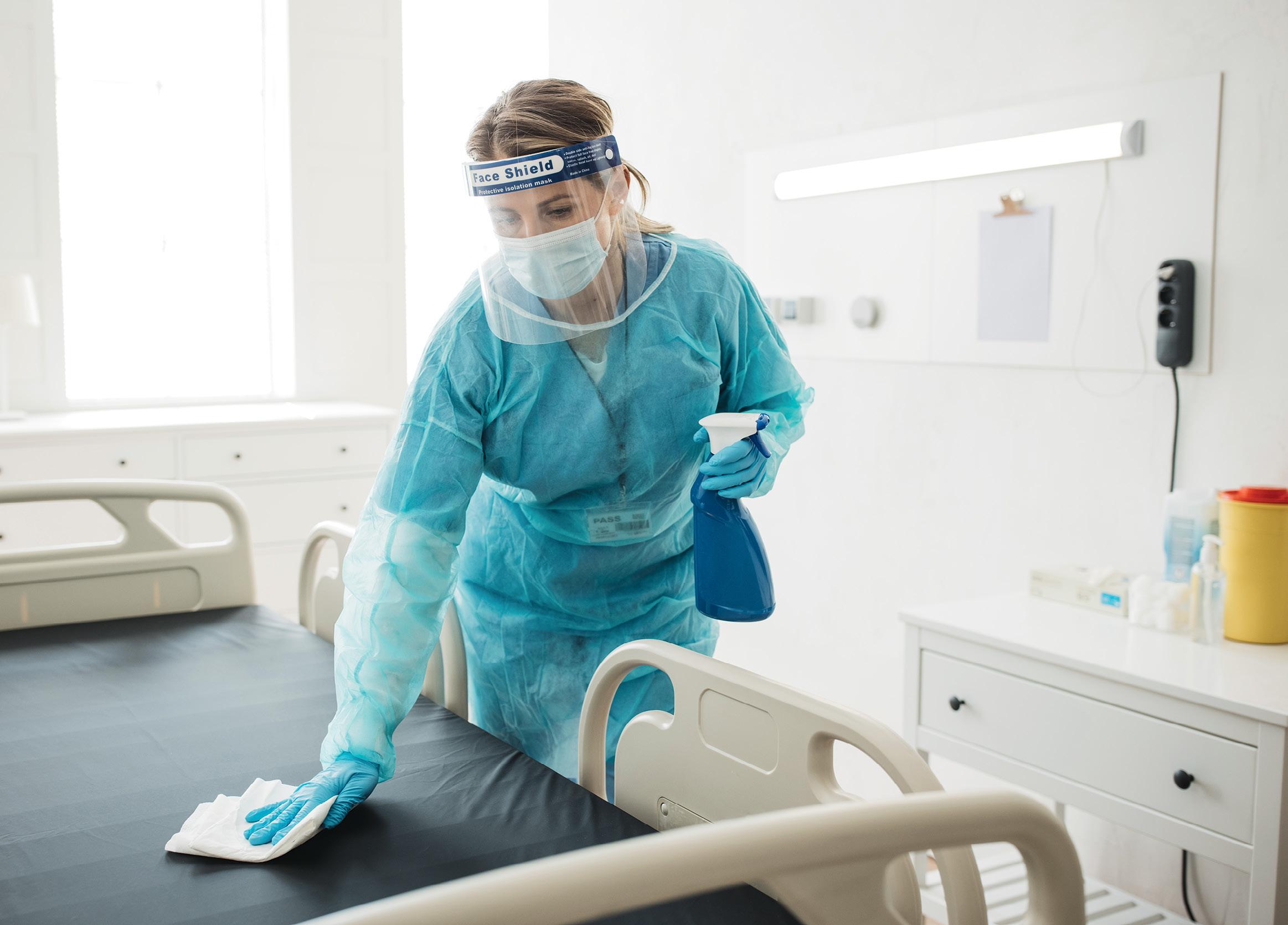
Boon says one key focus for any cleaning operator must be to get their processes right. While the choice of appropriate machinery and chemicals is crucial, the risk to aged
care residents and others can stem from the inappropriate use of that technology and products. This includes rigour around the most efficacious dwell time for chemicals.
“It’s all about having the right processes,” Boon says. “You can have the best machines and products in the world, but if they’re not used properly the outcomes won’t be good.”
To that end, Proquip is introducing online training programs to ensure that cleaning staff are using cleaning equipment in the right way.
COMMUNICATION CRUCIAL
With the stakes being so much higher in the aged care sector with hygiene control, Boon stresses the importance of clear communication between facility managers, cleaning contractors and distributors.
He believes site managers are more open to discussions now about new innovation and technology options in the wake of COVID-19, whether it is around steam-cleaning products or better chemical choices.
“They’re more receptive to new ideas,” he says. “And, because COVID has been such a big health issue, they generally have more funding available
“
People now realise that a world without cleaners will come to a screaming halt ”
24 INCLEAN NEW ZEALAND November 2022 AGED CARE
Penny Barrett, Team Leader for vocational pathways and the cleaning sector, Careerforce
for hygiene solutions now, whereas five years ago if they applied to head office for a $12,000 steam machine, for example, it would have been a tough ask.”
Barrett has no doubt that higher protocols around hygiene and cleaning are here to stay in the wake of COVID-19. She also believes there is greater understanding in New Zealand about the need for upskilling and education within the hygiene and cleaning space.

With unemployment levels hitting historic lows across the country, the cleaning sector is struggling to recruit and retain appropriate talent.
“But there are good opportunities in the
cleaning sector for employment pathways,” Barrett says.
Retention rates for cleaning staff are more stable within hospitals because of better pay rates and employment deals under MECA agreements.
However, Barrett believes the key in the future to having a steady pipeline of workers in the aged care sector and others is to strengthen gateway programs in secondary schools.
She says one element that favours the cleaning sector is a renewed appreciation of cleaning as a result of COVID-19.
“People now realise that a world without cleaners will come to a screaming halt.” ■
The
“
” 0800 277 486 careerforce.org.nz/cleaning “Our investment in training has helped staff motivation, retention, and client satisfaction.” Careerforce is a business division of Te Pūkenga Work Based Learning Ltd
Percival, Kleenrite Customer Services Manager Talk to us today about upskilling your cleaning staff via our workplace-based training programmes! AGED CARE
imperative of high hygiene standards as a result of the pandemic has prompted some training reforms in New Zealand, especially for the hospital and aged care sectors.”
Yvonne
Making a difference
Cleaning industry operators across New Zealand are engaging in a raft of sustainable projects and initiatives which are helping their people and the environment, while also delivering efficiency benefits for their businesses and customers.
Words Cameron Cooper
As RapidClean rolls out its cleaning chemicals across New Zealand, customers may spot some colour variations with the containers being used.
The cleaning products business’s new Environmental Choice New Zealand (ECNZ)certified range of chemicals is delivered in 5-litre and 15-litre bottles made from 75 per cent postconsumer recycled milk and water bottles.
This move is just one of many that RapidClean is taking as part of its push to embrace sustainability, including offering a surfactantfree dishwashing detergent.
The original bottles are collected from recycling depots around New Zealand, with the flattened bottles then being out through a chipper at a plastic recycler that also removes labels and washes the plastic. The chips are then manufactured into the containers, which can
have some minor discolouration because of the recycling process.

































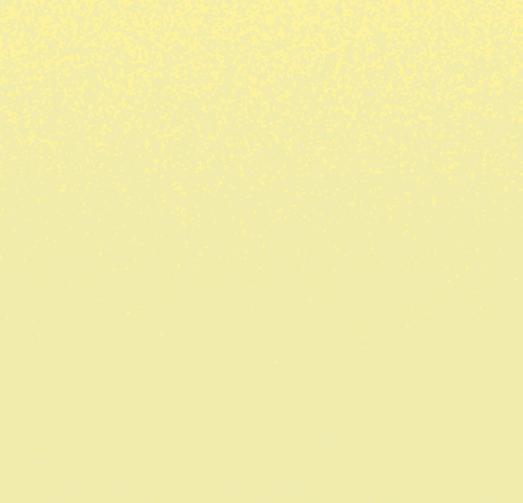




































“It’s been a good initiative,” says Geoff Hughes, national manager at RapidClean New Zealand.

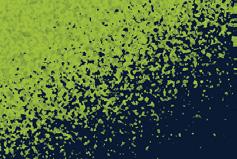
“More and more customers are asking for products to be as environmentally sustainable as possible.”
A SMART, SENSIBLE APPROACH
PPCS, a leading provider of facility and cleaning services throughout New Zealand, is another company that is committed to sustainability, with the four key pillars of its strategy focusing on ‘people’, ‘environment’, ‘procurement’ and ‘community’.
Whether it is backing a MECA deal to provide workers with wage protections, choosing electric and hybrid vehicles for its fleet, or using greener cleaning processes, PPCS wants to adopt sustainable practices in a sensible way.
26 INCLEAN NEW ZEALAND November 2022 SUSTAINABILITY
Executive general manager Sarel Bloem cites the use of ionised water on commercial cleaning jobs, where applicable, to cut down on the use of harsh chemicals.
“Our view of sustainability is that you must be able to repeat a process indefinitely,” he says. “So, from time to time you may have to use cleaning products that are a little more aggressive than the ionised water. Public toilets are a good example – you can clean them with a green product six days a week and then go with something stronger one day a week.”
On the people front, PPCS has been partnering with Earthlink, a not-for-profit group that provides education, training and supported employment opportunities for people with mental health and physical challenges.
Under the program, workers collect e-waste such as old phones and tablets that would normally end up in landfill. Instead, it is taken to Earthlink for a range of recycling initiatives.
Bloem says the concept pays off on a number of fronts, in addition to creating meaningful jobs.
“We’re no longer paying for all the landfill costs. Earthlink takes the waste off us and refurbishes what they can. But what they can’t refurbish they’ll strip anything of value out and on-sell that to fund Earthlink.”
PEOPLE POWER
Supercare managing director Ian Kebbell says sustainability initiatives are becoming an ever-increasing part of the national commercial cleaning services provider’s “non-pricing attributes”.
“More and more, customers who we are partnering with are looking to understand how we can work with them on sustainability issues,” he says.
“
















We’ve taken the view that for us to be a sustainable and viable business that continues to trade going forward, we must set a band of pricing and stick within that band. If we go cheap and we’re not here tomorrow, we don’t win, our people don’t win, and our customers don’t win. It’s something as an industry that we need to be aware of. ”
Ian Kebbell, Managing Director, Supercare

Supercare is a member of Diversity Works New Zealand, the national body for workplace diversity, equity and inclusion.
Kebbell says that alliance helps his team sustain a workplace in which mindfulness and wellbeing are supported.
Using a framework from Diversity Works NZ, a team of regular Supercare staff members – not senior management – are assessing the business’s diversity efforts, including rating performance in relation to culture, gender and the physical and mental make-up of the team.
Kebbell says senior managers are not part of the assessment team for a reason.
“This must be driven from the coalface up. Often, we sit behind our desk and think we know what’s going on, but as part of our learning we need to hear from our people.”
In addition to improving the satisfaction and lives of workers, he believes such diversity initiatives have pay-offs for Supercare.
“If we have people who stay with us, that’s less time and money that we have to spend looking for new people.”
According to Kebbell, one of the big issues Supercare will have to stay on top of in coming years is pricing. In short, he wants to commit the business to charging appropriate prices for its services that allow the business to thrive and for employees to get a fair wage.
“The traditional race to the bottom with pricing in the cleaning industry is rearing its head again. We’ve taken the view that for us to be a sustainable and viable business that continues to trade going forward, we must set a band of pricing and stick within that band. If we go cheap and we’re not here tomorrow, we don’t win, our people don’t win, and our customers don’t win. It’s something as an industry that we need to be aware of.”
SUSTAINABILITY www.incleanmag.co.nz 27
NATIONAL EFFORT
Although New Zealand has an international reputation for being clean and green, a government report from 2020 has highlighted high pollution levels in its freshwater rivers.
The study found that almost 60 per cent of the country’s rivers carry pollution above acceptable levels, with 95 to 99 per cent of rivers in pastoral, urban and non-native forested areas being contaminated.
Hughes says farmers are engaged in remediation actions to address the river issues, while business’s such as RapidClean have a role to play, too. That includes committing to the group’s ECNZ-certified cleaning solutions covering washrooms, floors and surfaces, glass, kitchen degreasing and multipurpose tasks.
“People are very keen to do the right thing by the environment and part of that is what we’re doing with our chemicals,” Hughes says.
“A lot of chemicals are not sewer-system friendly, and they end up killing off the natural bio-enzymes in those systems, whereas ours don’t.”
He says members of the RapidClean group are switching to green products where possible, while many of the group’s preferred suppliers are also introducing more sustainable and reusable
products, which contributes to a greener supply chain overall.
“You must have the backing of all parts of the supply chain,” Hughes says.
While the ECNZ certification process took years and included rigorous peer reviews to ensure the chemical formulations meet appropriate standards, Hughes welcomes such rigour.
“I think it’s good that it takes that long because it means the process is very thorough.”
As part of its green efforts, PPCS now has 16 electric vehicles and 25 hybrids in its fleet. The company policy is to favour EVs whenever possible, or to go with hybrids for those staff members who need to make longer trips. Trucks with combustion engines are only acceptable if all other options are not feasible.
Bloem says PPCS is even starting to distinguish between hybrids, mild hybrids and plug-in hybrids, with the latter having the advantage of a larger battery pack that can be recharged externally and which is seen as the most sustainable of the hybrid vehicles.
“Although the plug-in hybrid costs more to buy, we’re now compensating for that by driving our vehicles for slightly longer. Previously, we’d drive them for four years or a certain number of kilometres, but we’re now pushing that to five to
“
More and more customers are asking for products to be as environmentally sustainable as possible. ”
28 INCLEAN NEW ZEALAND November 2022 SUSTAINABILITY
Geoff Hughes, National Manager, RapidClean New Zealand.
•
six years to make them more cost-effective.”
While many EVs come with a price premium, Bloem says PPCS has found ways to get around that issue. “If we had to go for the top-end EVs and hybrids, it wouldn’t make sense. But by going for mid-range vehicles and being a bit smarter, it pays off.”
KEEP IT SIMPLE
Bloem believes simple measures can make a difference with sustainability.
For example, PPCS’s cleaning services of low-cost housing estates for Wellington City Council uncovered a high proportion of contaminated waste in recycling stations. At the suggestion of one of the company’s waste-truck drivers, recycling bins were moved slightly further away from homes – resulting in committed recyclers continuing to use the stations, while “lazier” people just kept putting all their rubbish in general bins closer to their premises.

“The amount of contaminated waste for recycling dropped drastically,” Bloem says.

Other actions are also making a difference, too. PPCS continues to expand a successful project featuring solar-powered smart-waste
compactor bins, called the Big Belly Bin, into New Zealand’s largest shopping centre, Sylvia Park, and for Auckland Council in the west. The bin reduces rubbish collections dramatically and requires fewer waste-truck visits to the sites.

For Bloem, the way forward on sustainability will see PPCS continue to finetune such projects and be conscious of exploring new opportunities.
Kebbell agrees that true sustainability does not require a “bigbang approach”. “
It’s a lot of little things that make a difference.”
For instance, Supercare has been using GPS systems to track its vehicles and determine the shortest, most fuel-efficient routes. It is an easy move that helps.
“For some SMEs, in particular, with limited resources, what all too often happens is that you get so scared of the sustainability topic. You think you have to make all these major changes to be effective, and therefore you end up doing nothing,” Kebbell says.
“For us, sustainability doesn’t have to be expensive or resource hungry. It’s just about being mindful of it and having an impact.” ■
•
•
•
•
•
•
•
•
CANISTER VACUUM WWW.RAPIDCLEAN.CO.NZ | 0508 727 433 NEW RapidClean’s Glide 300 is a great pull-along option for commercial and domestic environments that require regular, detailed cleaning.
1300W single-stage flow through
•
Noise level (at 1.5m) 64dB(A)
52 litres p/sec airflow rate
Lightweight 5KG
Capacity 15L
Reusable 15L SMS dust bag
Paper disposable 15L dust bags (5pk)
18m power cord
3-stage filtration - high filtration filter
2 year body and motor warranty SUSTAINABILITY
Disaster-recovery restoration
– how to be prepared and respond
Storms, floods, and fires are a constant threat in Australia and, when it comes to the clean-up afterwards, experienced restoration experts are worth their weight in gold.
 Words Cameron Cooper
Words Cameron Cooper
To suggest that restoration expert Scott McFadzen is in demand as floods keep inundating multiple areas of Australia would be an understatement.
As director of Coach8, an approved instructor by the Institute of Inspection, Cleaning and Restoration Certification (IICRC), he specialises in delivering training courses and engaging in the restoration of commercial spaces and property after floods and other natural disasters.
“We say we’re in storm season now, but the storm season hasn’t stopped all year,” McFadzen says. “So, there’s been an increase with regards to specialised training.”
During his decades of experience, he has seen all the restoration mistakes and missteps that are often taken in the rush to clean up after extreme events.
For facility managers, homeowners, and cleaning contractors facing such a clean-up, McFadzen offers the following broad tips.
30 INCLEAN NEW ZEALAND November 2022 RESTORATION
1. Conduct a comprehensive audit of the site
An initial health and safety walk-through at an affected site is crucial to assess the damage and determine appropriate restoration actions. After eliminating initial hazards and removing floodwater, silt, debris and porous content, the space needs to be washed out. During this phase, McFadzen says it is important to do an inventory of damaged contents and any contents to be disposed of for insurance purposes.
2. Clean first, then do the restorative drying
Too often, McFadzen says, people place drying machines into a flood-damaged home or office before cleaning up contaminated materials, remembering that Category 3 water from a river flood is the same category as having sewerage flow through a premises.
“We regularly hear of people installing restorative drying equipment into a property where contaminated materials are still in place,” he says. This uncontrolled airflow can spread dangerous microorganisms, which affects indoor air quality and can cause health issues for occupants.
3. Remove fungal activity from the site
Removal of mould typically involves many forms of cleaning, including wet wiping, HEPA-filtered vacuuming, and an abrasive cleaning method where appropriate on semi-porous surfaces and non-porous surfaces. McFadzen says a common mistake is to blast a site with bleach or other chemicals in an effort to remove mould.
“With the removal process, we don’t want to rely on spraying a chemical or a bleach over mould. We call those guys the spray-and-pray brigade – and that’s where they just spray a chemical over something and pray that it works.”
Any use of disinfectants and cleaning products should be in line with the manufacturer’s guidelines.
McFadzen also warns against overly destructive clean-up activities. While knocking holes in walls may be recommended by an insurance company on occasions to get airflow through a site, there is a risk of causing secondary damage to elements such as tiles that may not need to be removed. There is also the danger of disturbing regulated materials. “So, telling people to go and smash holes in walls is not appropriate,” McFadzen says.
4. Communicate with all parties
Communication between restorers, builders, insurers and property owners is crucial, from the start to the end of a project. Documentation of all processes during a clean-up should also be rigorous.
“Communication is one area where a lot of restorers and builders fail,” McFadzen says. “We always need to engage with clients and let them know what’s happening.”
McFadzen also encourages the use of specialist restoration experts where required. This could include experts in restoring everything from musical equipment through to weaponry.
THE RIGHT EQUIPMENT AT THE RIGHT TIME
Floods have also been the recent focus for XPOWER Australia, a national supplier of equipment such as air movers, air purifiers and dehumidifiers.
National sales manager Brett Low says recent floods in Queensland, NSW, Victoria, Tasmania, and the Northern Territory have created unprecedented demand for floodrestoration services and equipment.
“You can almost bank on floods decimating areas, unfortunately,” he says. “We just know it’s going to happen.”
Low says property owners and cleaning contractors that rely on drying machines after floods should be conscious of supplychain disruptions.
“When a disaster hits, there’s never enough stock,” he says. COVID-19-related supply-chain disruptions have exacerbated the problem.
However, XPOWER has opted to hold large quantities of stock and “sit on it for six months at a time” to help ease supply woes.
“You need to have stock available should an event happen and that’s one of the things we’ve focused on.”
XPOWER offers a range of equipment, including axial fans to circulate air, dehumidifiers for humidity control, and air scrubbers to help remove mould spores.
Low says the three machines should be used in conjunction with each other, in the right order, for the best results. It is also advisable to seek input from experienced drying professionals to ensure the right equipment is used for the right jobs.
“For instance, it’s pointless putting in a dehumidifier that works best in temperatures of 32C into a property in Far North Queensland where the ambient temperature might be 42C,” Low says. “It just won’t work.”
“
Storms, floods, and fires are a constant threat in Australia and, when it comes to the clean-up afterwards, experienced restoration experts are worth their weight in gold. ”
www.incleanmag.co.nz 31 RESTORATION
How to avoid common mistakes with disaster clean-ups
Infectious diseases expert Dr Gavin Macgregor-Skinner says a lot of people and some cleaning and restoration companies make fundamental errors during clean-ups after natural disasters, including floods. He offers the following advice.
1. Stop using bleach (sodium hypochlorite)
Multiple research reports have shown that bleach should be avoided as part of disaster-recovery cleaning efforts, according to Dr MacgregorSkinner, senior director of the Global Biorisk Advisory Council (GBAC), a division of ISSA.
“Bleach does not kill mould,” he says. “Bleach may make mould go clear, but it doesn’t kill mould and it’s toxic. People honestly believe they’ve killed the mould by bleaching it, and don’t realise they have only eliminated the stain, not the spores, and not the mould. We’ve got to fix this urban myth.” Dr Macgregor-Skinner’s frustration rests with many authorities and “selfcalled experts” who continue to recommend the use of bleach in public messages after disasters. Instead, he recommends using a product that is cheap and readily available such as white distilled vinegar, which is proven to kill mould spores and help prevent mould outbreaks in the future. Spray the vinegar directly on to the mould, and let it sit for at least 60 minutes before wiping or scrubbing.
2. Resist throwing out salvageable items
During the recent floods in Lismore and Murwillumbah in northern NSW, the sight of people throwing out refrigerators frustrated Dr Macgregor-Skinner. “You can clean and disinfect a refrigerator,” he says. Other household appliances could also be rescued, he says, but in rushed clean-ups they are often sent to landfill.
3. Be selective with ‘aggressive’ high-pressure cleaners
The screech of high-pressure washers can be heard after every flood as well-meaning people try to clean up homes, offices and equipment. “But it damages stuff,” Dr Macgregor-Skinner says. For example, using such machines on roof tiles can strip off protective coatings that leave them vulnerable to bacteria, viruses and mould. They can also damage the surface of floors and tables, while they tend to aerosolise dangerous bacteria. Rather than using high-pressure washers to remove material, for your home use low-pressure cleaning instead. “After a flood, we’re too abrasive with our methods and we damage our brickwork and tiles and all the surfaces that need to be protected.”
4. Get some microbial test kits
When a flood goes through an office or house, it will almost certainly contain oils, chemicals, pollutants, germs, bacteria, fungi and mould.
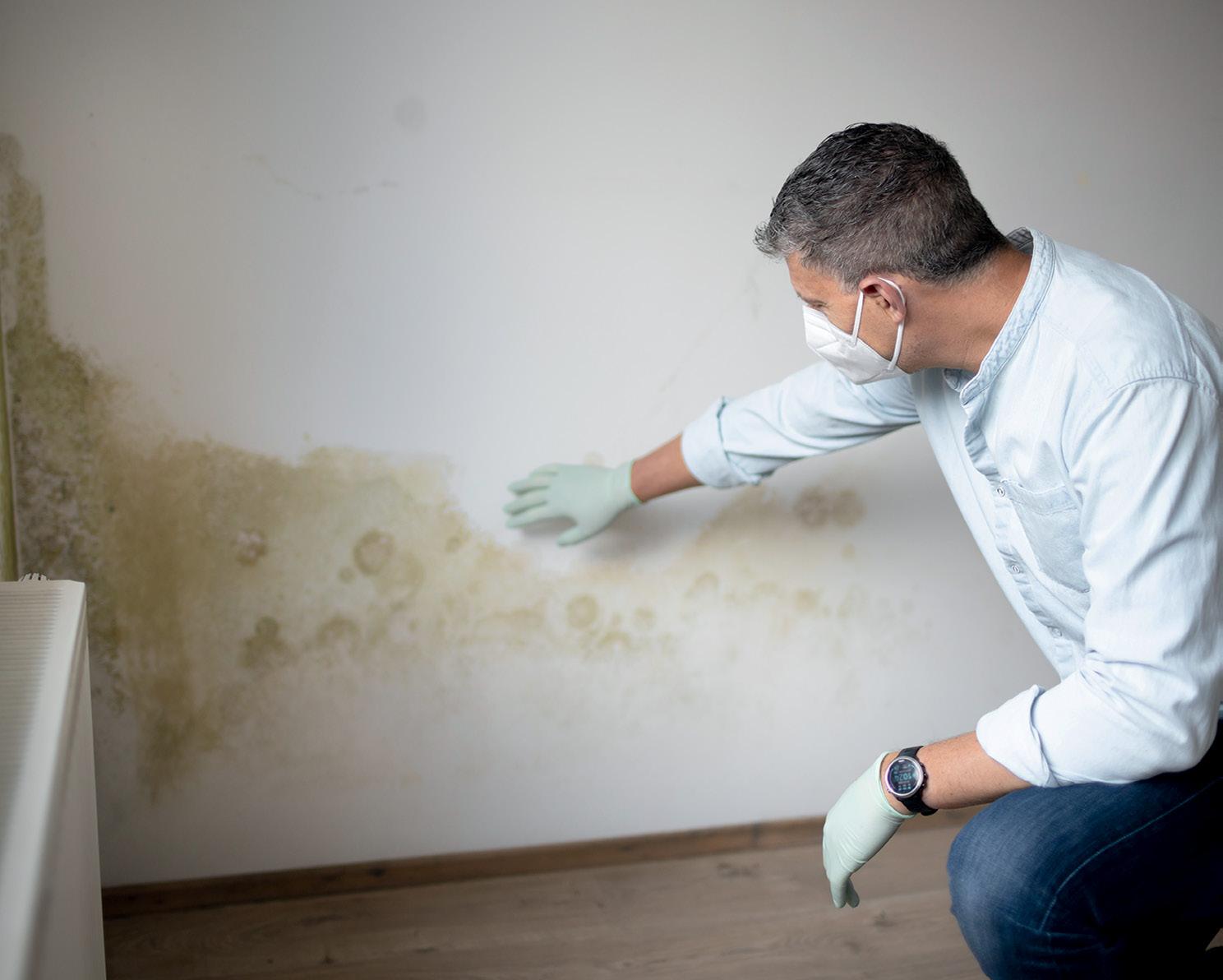
“It’s a toxic swamp that’s gone through your house,” Dr Macgregor-Skinner says. That means real rigour is required in the clean-up. Just because something looks clean does not mean that it is. Dr Macgregor-Skinner says after cleaning houses following a disaster, the owners or cleaners rarely turn to microbial test kits to see if the property is safe.
“Everyone goes, ‘Well, it looks clean and smells clean, so we’re safe to go back in, but you need to test first.”
“
Communication between restorers, builders, insurers and property owners is crucial, from the start to the end of a project. Documentation of all processes during a clean-up should also be rigorous.
32 INCLEAN NEW ZEALAND November 2022 RESTORATION
”
Environmentally Sustainable Specialist Cleaning Services
CrestClean offers a range of specialist services to help maintain buildings and premises, including Hard Floor Cleaning and Maintenance, Carpet and Upholstery Cleaning and Pure Water Window Cleaning.
Our cleaning services meet the strict environmental criteria set by Environmental Choice NZ. This helps to improve the sustainability of our cleaning services and allows our customers to verify sustainable procurement.


STAY UP TO DATE WITH RULES AND REGULATIONS
Restorers, builders, and cleaning contractors should always stay abreast of the latest guidelines in relation to clean-ups. For example, the IIRC has published the fifth edition of the S500 Standard for Professional Water Damage Restoration, which describes the necessary procedures and precautions for performing waterdamage restoration in residential, commercial and institutional buildings.
McFadzen says staying up to date with training and education is vital.
“Anyone getting involved in flood remediation needs to be competent,” he says. “They also need to understand the health and safety risks. When they’re dealing with floodwater, it’s coming from external sources and it’s carrying a largely unknown source of contamination that needs to be remediated correctly.”
Furthermore, he believes restoration experts need to commit to ongoing training, rather than doing a one-off course and thinking that it will be sufficient.
“Standards are always being renewed and revised,” McFadzen says. “Continuous training is important because you should always be learning.” ■
Find out more at crestclean.co.nz
www.incleanmag.co.nz 33 RESTORATION
How to conduct a product audit
One of the impacts of the pandemic is that all cleaners, including carpet cleaning professionals, are taking a second look at the products and cleaning solutions they use.
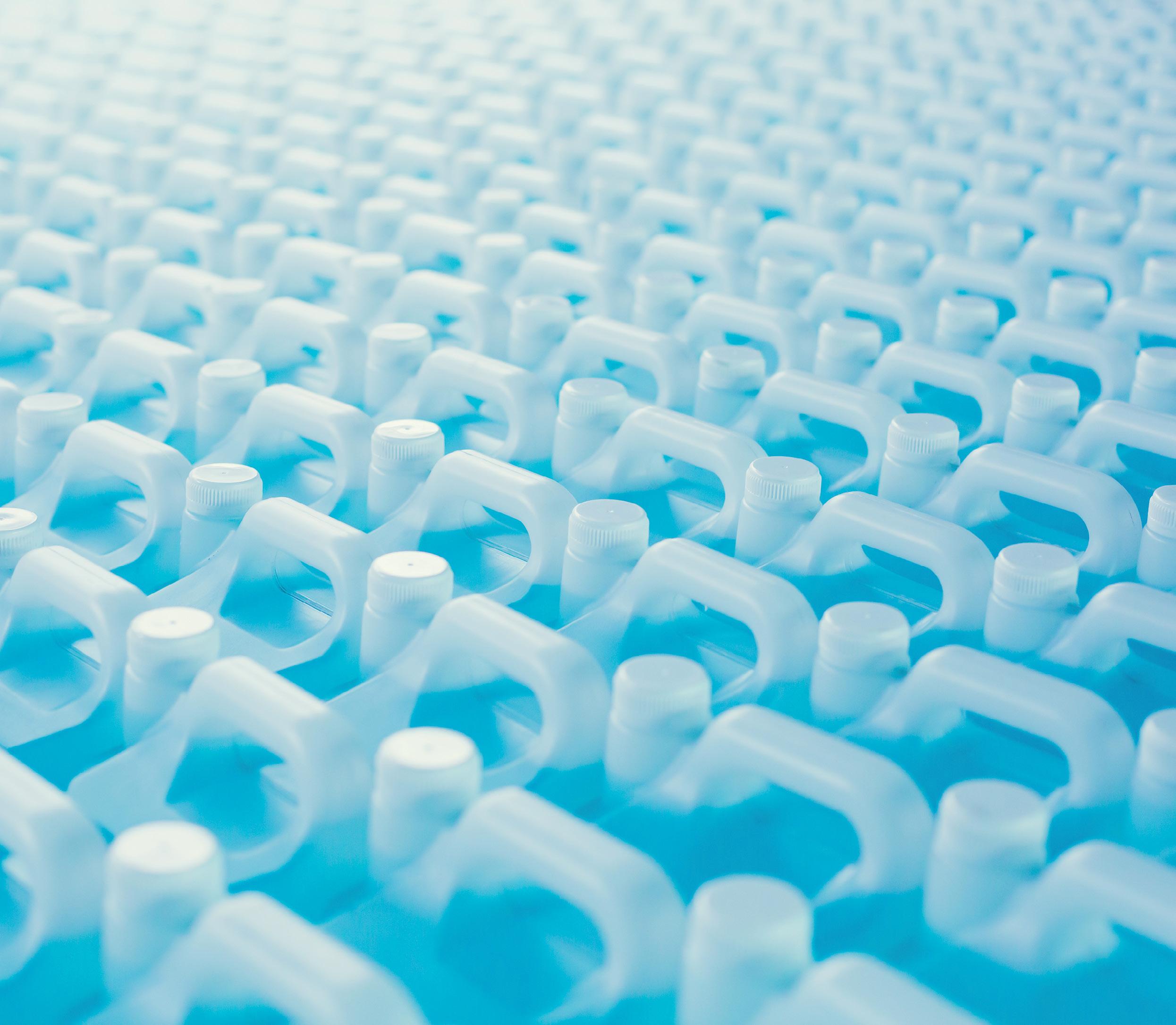
They are evaluating them based on several criteria, including which are best at protecting occupant health (a top consideration during the ongoing pandemic), which are safest for technicians to use, which perform well, and also which are most cost-effective.
Examining such issues subjectively is not always beneficial. We need a formal investigation, and in most cases, this is accomplished by conducting a product audit.
Usually, these are best performed with three or more people who are familiar with the products being analysed and who use them regularly.
PRODUCT AUDIT PROCESS
There are a few basic steps and best practices to follow to ensure an objective product audit. Before conducting the evaluation, consider the following:
• Price and performance often do correlate (you typically get what you pay for), but this is not necessarily true in all cases. Price should not sway the evaluation of a product’s effectiveness, so focus first on objective product performance when conducting a product audit. Consider the costs of the product later.
• While those involved in the product audit should be familiar with the products, it may be warranted to get additional product feedback from clients where the product is used.
• Allow enough time to conduct a product audit thoroughly. Important decisions can come from a product audit, which can impact your business for several months, or even years, into the future.
Words Michael Wilson
Product audits can help clarify which products are best suited to your needs, streamlining your purchasing.
CARPET CLEANING 34 INCLEAN NEW ZEALAND November 2022
Once you have selected the products to be evaluated, assembled your audit team, and set aside the necessary time, follow these basic steps for conducting a product audit:
• All products used for the same or similar purpose are evaluated at the same time. However, to make the process easier, limit yourself to four products at a time. An example would be a comparison of four different spotters from four different manufacturers.
• As they are evaluated, each product is given a score indicating effectiveness, ease of use, and overall performance. A typical scoring method is a rating in each category of one to five with one being poor and five being excellent.
• After the performance evaluation is complete, reveal the price of each product and rate according to cost-effectiveness with a one being very costly and a five being very cost-effective. Be sure to account for any differences in concentration so that the price per volume is consistent across products.
• All scores are then averaged for all products being evaluated.
PRODUCT AUDIT IN ACTION
Now that we know the basics of conducting a product audit, let’s take a look at possible results using the following scenario.
Four products, A, B, C, and D have been analysed. Products A and C receive low (poor) evaluations, while products B and D have comparable high evaluations. The company chooses to stop purchasing products A and C due to their poor appraisals.
Products B and D both perform and cost about the same. However, the auditor wants to select only one of these two products. When this happens in a product audit, we must investigate other factors that could influence which product is best for the company. In this case, the company considered the following:
• Product B has been used for several years by all the technicians. No additional training is required to use this product.
• Product B is green certified, whereas product D is not. Because many clients want environmentally preferable cleaning products, this gives product B the upper hand.
• Product D is sometimes in short supply, which could pose problems in the future. Adding these factors to the evaluation makes clear that product B is the best choice for this company.
OTHER BENEFITS
In our scenario, the company decides to purchase and use only product B. Making such a decision has several benefits.
The first is cost savings: Eliminating the purchase of the other products will help reduce costs. Further, purchasing large quantities of product B can result in possible discounts from the manufacturer or supplier.
Additional benefits include the following:
• More closet/truck space: Storing one brand of cleaning solution takes a lot less space than four different ones.
• Less confusion: Fewer products means minimising the likelihood of selecting the wrong product for a specific purpose.
• Greater safety: Different cleaning solutions may have different safety concerns. Minimising the number of products used helps workers know their products, ensuring worker safety.
• Revelation: Often when a product audit is conducted, it is the first time we actually evaluate the products used in our everyday work. Expect a few surprises to be uncovered in the process like technician dissatisfaction with a product’s performance.
KEEP AUDITING
As to how often a product audit should be conducted, the answer is that it can vary. If no new products are selected or used after completing one product audit, another product audit may not be necessary. However, new products are often introduced over time. When this happens, companies find they are in the same boat as before, purchasing several products, all used for the same or similar purposes. That’s when it’s time to conduct another product audit and refocus product purchasing once again. ■
Michael Wilson is AFFLINK’s vice president of marketing and packaging. This article was first published in Cleanfax magazine and has been republished with permission
“ One of the impacts of the pandemic is that all cleaners, including carpet cleaning professionals, are taking a second look at the products and cleaning solutions they use. ”
CARPET CLEANING www.incleanmag.co.nz 35
Office spaces:
Is your business set up to protect people from germs?
As Australia continues to open and lift all COVID-19 border restrictions1, latest research from Reckitt indicates 74 per cent of Australian consumers remain concerned about the spread of germs.2
According to data from the ABS, in April 2022, despite more people working from home than at the start of the pandemic, more than half (53.8 per cent) of Australians hadn’t worked at least one day a week from home in the previous four weeks, indicating that for many, a return to office work is now the norm.
A March 2022 survey commissioned by Reckitt’s Lysol Pro Solutions and conducted by Suzy in the
United States, found 53 per cent of American office employees were travelling to their company’s office every day, with 30 per cent going into the office a few times each week3. Yet only 27 per cent of respondents believed that their company’s health and safety measures were being enforced to the highest standard4.
While yes, this is research from overseas, the survey underscores the importance of an effective and well-enforced office hygiene program to help protect and inspire confidence among employees.
As we found ourselves during the colder months, with NSW hospitals reporting in May 2022 an influx of COVID-19, cold and flu cases5,

FACILITIES MANAGEMENT 36 INCLEAN NEW ZEALAND November 2022
it’s a good time to be reminded that if you are an employer, you’re required by law to put into place protective measures to limit the spread of germs in the workplace6
Here are some steps you can take to help ensure your space, and team, are protected.
A COMPREHENSIVE PLAN THAT PROMOTES COLLECTIVE RESPONSIBILITY
The office environment, where groups of people share spaces, can be a source of germ transmission.
Employers need a robust cleaning and disinfection regimen that is both backed by comprehensive, science-backed protocols, and engages employees to participate in the office hygiene experience.
Employees should play a role in disinfection, however, they need solutions to help protect themselves and their colleagues in the office, including the necessary products and education.
Regularly stocked sanitiser should be made available where a wash basin isn’t possible (i.e. at the office entrance), soap dispensers in bathrooms should be full with signage to remind those to wash their hands (consider putting this on the back of cubicle doors), and wipes should be present for employees at their desks and in shared common areas such as break rooms and kitchens.
What’s more, understanding where and when to direct cleaning and disinfection measures is critical.
IT’S ALL ABOUT ‘TARGETED HYGIENE’
A keyway to help minimise the spread of germs on surfaces is to take a ‘targeted hygiene’ approach.
Rooted in research and rigour, targeted hygiene refers to the practice of putting into place hygiene surface and hand hygiene interventions when and where they are most needed7,8.
Based around risk management and efficacy, targeted hygiene focuses on what is needed to help stop the spread of germs, pointing businesses towards cleaning smarter, not just harder, and encouraging hand hygiene at key moments, rather than saying just “frequently”.
Research has shown that high-touch points such as door handles9 and hand dryers can become contaminated by dirty hands, allowing
germs to be transferred onto the hands of the next person to touch them10. It therefore makes sense then for these kinds of items to be cleaned more frequently at intervals that reflect their likely use (you don’t worry so much about areas where they are not being used) so you target the frequency accordingly.
Once targeted hygiene protocols have been developed, it is important to ensure your office’s cleaning teams are trained so they understand when, where, and how to clean.
Monitoring is always part of any good cleaning system to ensure spaces are not only being cleaned and disinfected in accordance with government health advice, but also so protocols can be adapted based on footfall of the office space. For example, if the space is only being used two days a week versus five, then protocols should be adapted accordingly.
When it comes to compliance and use of protective measures such as hand sanitiser, if you notice that the dispensers need refilling less frequently, it might mean that it needs to be placed somewhere more accessible and visible, or perhaps your messaging to encourage its use needs revisiting.
PARTNERING WITH SPECIALISTS
While the Australian Government provides excellent advice on cleaning and disinfection, employers and facilities managers also can turn to experts for how to best protect employees in the office.
Drawing on science-based targeted hygiene, which helps determine where, when, and how germs spread, Dettol Pro Solutions recommends the appropriate products and protocols to create protected spaces.
As employers and employees return to the office, employees are placing trust in their employer that the business is doing everything they can to help create a comprehensive hygiene program which reinforces enhanced disinfection measures. Employee-empowered hygiene not only helps protect the business, but also puts a culture of care in place at the office. ■
Jonathan Weiss is commercial director of B2B for Europe, Australia and New Zealand at Reckitt
1 Home Affairs, All COVID-19 border restrictions to be lifted, Home Affairs, Accessed 4 July 2022 <https://minister.homeaffairs.gov.au/ClareONeil/Pages/covid-border-restrictions-to-be-lifted.aspx>.
2 Reckitt Toluna Tracker, Wave 16 (6/7/2021-6/13/2021)
3 Lysol Pro Solutions, Suzy Return to Office Survey Results, Accessed 5 July 2022 <https://www.dropbox.com/s/qm0r62y0wzikfwu/Suzy%20%2B%20RB%20Lysol%20Pro_Return%20to%20Office%20
Results_1.4.22%5B1%5D.xlsx?dl=0>
4 Lysol Pro Solutions, Suzy Return to Office Survey Results, Accessed 5 July 2022 <https://www.dropbox.com/s/qm0r62y0wzikfwu/Suzy%20%2B%20RB%20Lysol%20Pro_Return%20to%20Office%20 Results_1.4.22%5B1%5D.xlsx?dl=0>
5 NSW Government 2022, Stay safe this winter get your flu shot now, NSW Government, accessed 4 July 2022 <https://www.health.nsw.gov.au/news/Pages/20220524_00.aspx>.
6 Business 2022, Keep you and your employees safe during COVID-19, Business, Accessed 4 July 2022, <https://business.gov.au/risk-management/emergency-management/coronavirus-information-and-support-forbusiness/keep-you-and-your-employees-safe-during-covid-19>.
7 The Case for Targeted Hygiene, 2019, Accessed 7 July 2022 at: https://journals.sagepub.com/doi/10.1177/1757913919864070#:~:text=Targeted%20Hygiene%20is%20an%20 approach,in%20Figures%201%20and%202).
8 Bloomfield SF, Rook GA, Scott EA, Shanahan F, Stanwell-Smith R, Turner P. 2016. Time to abandon the hygiene hypothesis: new perspectives on allergic disease, the human microbiome, infectious disease prevention and the role of targeted hygiene.Perspectives in Public Health. 2016;136(4):213-224. doi:10.1177/1757913916650225
9 Rheinbaben FV, Schünemann, S Groß, T, Wolff, MH, 2000. Transmission of viruses via contact in a household setting: experiments using bacteriophage φX174 as a model virus, Journal of Hospital Infection, Volume 46, Issue 1, Pages 61-66, ISSN 0195-6701, https://doi.org/10.1053/jhin.2000.0794.
10 Hygiene - Retail, supermarkets, and shopping centres, https://covid19.swa.gov.au/covid-19-information-workplaces/industry-information/retail-supermarkets-and-shopping-centres-2
“ Employers need a robust cleaning and disinfection regimen that is both backed by comprehensive, science-backed protocols, and engages employees to participate in the office hygiene experience. ”
FACILITIES MANAGEMENT www.incleanmag.co.nz 37
CLEANING UP the innovation process with ideas testing

Whether purchasing cleaning and hygiene products for use in commercial buildings or the home, buyers have a seemingly endless number of options from which to choose.
From the many multi-surface cleaners and hand sanitisers to disinfectants in spray and wipe formats, today there are even more brands and products trying to capture attention than before the COVID-19 pandemic.
How can cleaning brands ensure their product becomes the product that buyers reach for time and time again?
Innovation testing offers a window into consumer sentiment to help product developers and marketers put their best product with the most profit potential forward.
UNDERSTANDING ‘WISDOM OF THE CROWD’ METHODOLOGY
Securing insights from the market on products before they launch or ahead of a planned rebrand can be the difference between commercial success and disappointing sales.
So, how can organisations best approach ideas testing? Is a focus group comprised of customers or prospects the answer because they know the industry and the main challenges?
Or is there another approach that will yield valuable insights? In fact, crowds are better at predicting success than small, targeted groups of people because they don’t have a vested interest in the topic.
For example, the popular television game show Who Wants to Be a Millionaire leverages the ‘wisdom of the crowd’ idea by asking the audience for advice, which provides 90 per cent accuracy compared to the phone-a-friend method, which offers 65 per cent accuracy. By polling a large, diverse audience, organisations get the most realistic view of the in-market profit potential for their ideas.
A sample size of 500 respondents represents the general population and is proven to provide predictive accuracy.
The wisdom of the crowd method works even when products are not meant to be purchased or used by everyone in the sample audience.
Admittedly, people are often poor witnesses of their own behaviour, but more accurate at for casting how other people will behave.
Thus, high-quality testing platforms play to these strengths by framing the question not of whether the individual would buy the product, but whether they would invest in the idea.
A trading game that asks respondents whether they would buy or sell shares in the idea can determine predicted acceptance.
The answers, as well as the speed with which people make their decision, are key metrics. Ideas testing should also capture emotional response by asking individuals how the idea makes them feel.
The happier an idea makes someone, the more likely it is to be a success because people will want to select it over another option.
Bringing behavioural science into ideas testing provides an additional layer of accuracy so that development teams and marketers can be confident in their proposed concepts.
PUTTING IDEAS TO THE TEST
There are a number of ideas that businesses can test to support the development of a new cleaning product or understand how to update an existing product. These include, but are not limited to:
• Product concepts
Certain innovations in the industry saw a dramatic rise in adoption during the pandemic, in part due to the “hygiene theatre” that emerged. Now that cleaning concerns and frequencies have more or less levelled out, product development teams might wonder what professional cleaners and consumers will gravitate toward in the future. Concept testing offers advice on the ideas that might be worth bringing to market so that product development teams can invest their budgets and time wisely.
• Product name
Certain product and brand names are so catchy that they are now used to refer to an entire category, like Google. Becoming the next household name requires broad awareness and
TECHNOLOGY
38 INCLEAN NEW ZEALAND November 2022
Innovation testing offers a window into consumer sentiment to help product developers put their best product forward.
memorability. Ideas testing can help weed out names that won’t make their mark and highlight those that will be more engaging in an increasingly competitive market.
• Logos
Logos can become so recognisable that they become synonymous with the company itself. Many organisations in the cleaning industry gravitate toward logos that incorporate the colours green, blue, and white, and products that off er sustainability benefits are even more likely to use green to convey this messaging. But what makes a successful logo? Gaining feedback can help designers and marketers get their branding right so that it can become a familiar and trusted emblem.
• Packaging
While the Environmental Protection Agency (EPA) sets requirements for the proper labelling of cleaning products, there is a certain degree of flexibility with packaging, including the shape of the container, the colours and font used, the sizing of the text, and the placement of key claims and certification logos. Pack testing provides clarity on which elements are working and where improvements can be made.
• Claims and benefits
The pandemic shifted the public’s awareness of how closely
cleaning is tied to health and safety. But should that messaging still be the main focus when communicating how a product works and what differentiates it from other formulations or alternatives? Testing highlights which features and benefits will resonate the most with buyers.
CREATING THE NEXT GREAT CLEANING PRODUCT
While the formulations for cleaning products typically don’t change much over time, or even from one disinfectant to another, the cleaning industry still relies on innovation.
New products come to market to help professional cleaners conduct their tasks more efficiently and safely.


At the same time, new household cleaning and hygiene products emerge to enhance the cleanliness of consumers’ homes.
This has been especially true during the pandemic. Ideas testing can help product development and marketing teams align on the right product names, logos, packaging, claims, taglines, and more to maximise profit potential.
A platform that is based on the principles of wisdom of the crowd and enables quick, informative results makes the process more predictive and useful. ■
Lisa Buckler is senior vice president of Growth and Partnerships for System1. This article was first published in ISSA Today and has been republished with permission
TECHNOLOGY Get the equipment now, start paying in 6 months* Need professional carpet cleaning equipment now? Pay nothing up front, and then make regular repayments after 6 months.* *Terms and conditions apply To find out more about our delay payment plans, call 0800 277 678 or visit proquipnz.co.nz FAST AND EFFICIENT CLEANING 40VMAX XGT® BRUSHLESS STICK VACUUM makitasales@makita.co.nz www.incleanmag.co.nz 39
The 7Ms of better marketing
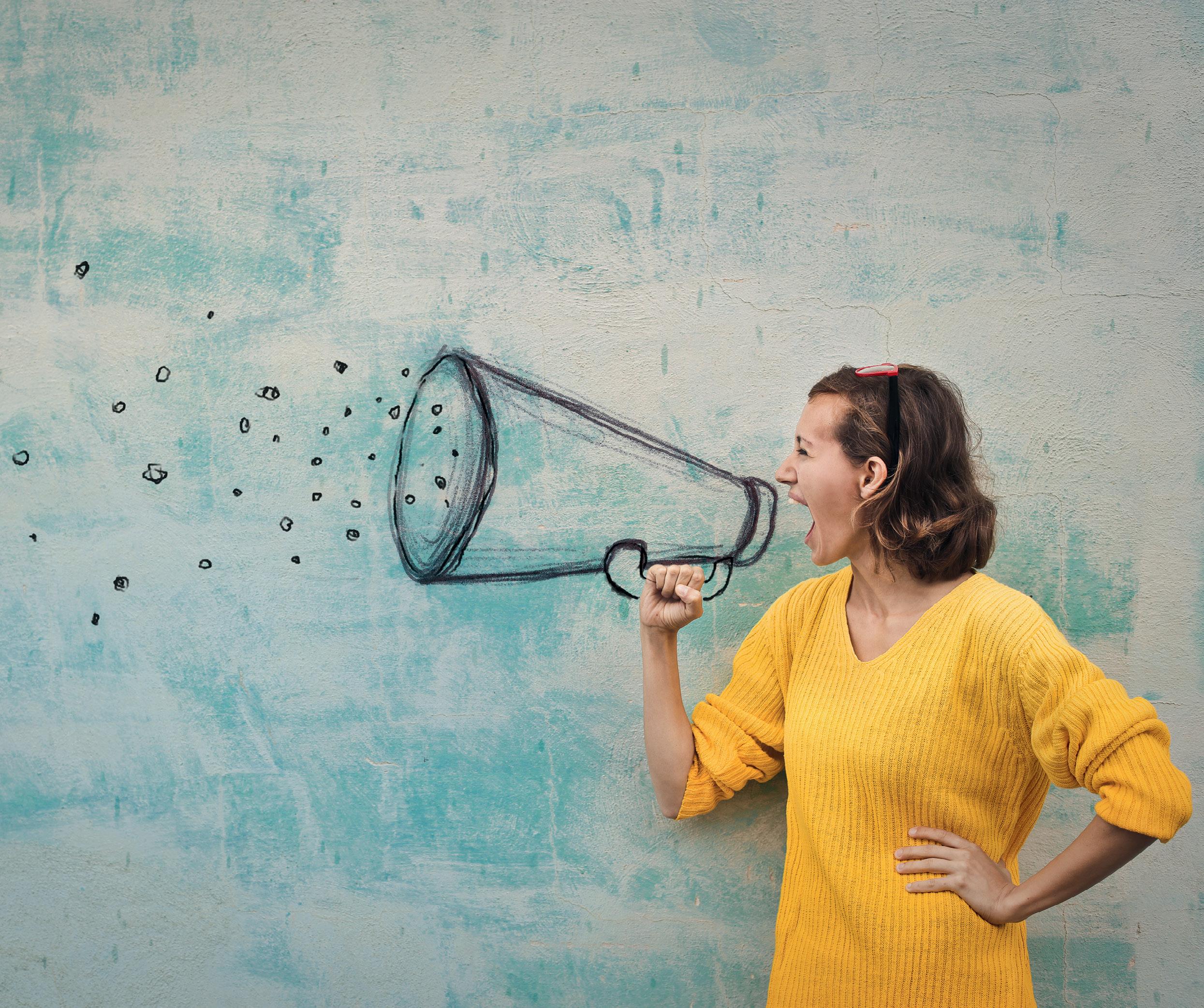
To
2. Money
1. Marketing mindset
The way you think about marketing is critical. Many cleaning and restoration business owners don’t plan their marketing. Instead of being proactive with their marketing, they are reactive. They market when things slow down, or they market when they have time. A marketing plan that is implemented consistently is the key to record sales and profits. Don’t wait until you need business to market your business.
Establish money goals. Do you have a sales goal? You should have a number chosen that you expect sales to hit for the year. Have you planned what your marketing budget will be? You should know how much you’re going to spend, on what, and when.
3. Mission
When it comes to marketing, you want to keep in mind what you are actually delivering. If you have not determined what your company’s mission is, you should come to terms with that before planning your marketing.
Your mission is the unique experience you want to deliver.
Not seeing the results you expected? Maybe it’s time to try a new approach.
make your company’s marketing process stronger, I’d like to look at what I call the 7Ms of phenomenal marketing. 40 INCLEAN NEW ZEALAND November 2022 MARKETING
•
Whatever your company aims to do for its customers, you should have a statement that expresses it. Your mission will determine who your target market is and what your marketing messages will look like.
4. Market
To determine who your prime target market is, think about who wants and needs the unique experience you want to provide. For example, since our mission is to help small business owners stop being slaves to their businesses, our target market is the small business owner who is open to change and ready to learn. This is only one type of business owner. Not every business owner is in our market.
For example, the “serial entrepreneur” — the one who is always starting a new venture, has a very short attention span, and gets distracted by bright, shiny objects — is not our prime target. They are just looking for the next big marketing wave to ride. That’s not what I do. Does that mean we don’t service serial entrepreneurs? Not at all. We just don’t target them.
Another type of business owner is the brandnew business owner. The problem here is that they have not yet experienced the pain of being in business. They don’t feel like slaves to their businesses. They are still on the “honeymoon,” so to speak.
Another example is my high-end service company in Houston. We decided that we would provide the “most outstanding service experience ever” — that we would have the best equipment and processes and be better-trained than anyone else. We would offer first-class, over-the-top customer service.
Guess what? Not everyone is willing to pay for that pricey, first-class experience. So, our target market became what we call “Mercedes clients.” It doesn’t mean they all drive Mercedes; it just means that they have Mercedes attitudes towards their indoor environments.
When I learned who my target market was, I was more successful because I then focused all my marketing and my coaching around the needs of my prime target market.
5. Message
Once you determine how much money your business needs to produce, what your mission is, and who your target market is, you now want to craft a message. What’s the message that resonates with your target market?
I have found that the high-quality prospects are looking for five things:
Reputation
Your message should create trust. This is done by communicating what others say about you. This can be referral sources as well as client testimonials and ratings. The benefit is they have
peace of mind that you will treat them right.
•
Experience
In the high-end market, the client must be convinced that you didn’t start yesterday. If you have been in business for a long time, be sure to communicate that and that you are experienced in all areas they may be concerned with. The benefit to them is that you or your team will know how to handle their situation. If you are new, focus on the next point instead.
•
Education
Communicate the training you and your team have received. The benefit is that you are on the cutting edge of what’s happening in your industry.
•
Systems
The experience your company provides will set you apart more than anything else, but you must communicate what you do that is different from others — and that experience must appeal to your target market.
•
Guarantee
Offering a 100 per cent, money-back guarantee takes the risk out of choosing your company for potential clients.
6. Methods
It seems that digital marketing is all the rage today. I’m still scratching my head, wondering why people would want to attract strangers from the internet while they ignore their repeat clients and referral sources.
My cleaning company generated over a million dollars in referral business last year. Why? Because we consistently implement our referral programs. And the other 2.4 million dollars in revenue? Repeat business. How do we do that? We consistently market to our past clients.
This is not just my company. Our industry has many referral-based companies that generate record sales and profits without traditional or digital advertising.
7. MAP
To get where you want to go, you need a Marketing Action Plan (MAP). Your MAP outlines what you are going to do every day, every week, and every month to reach your goals.
You could also call this your marketing calendar. It doesn’t have to be fancy; it just has to exist. You need a road map to follow. When you take the time to create a simple plan, you can then easily follow it.
Remember that the number one reason small businesses don’t grow, or do as well as they could, is failure to implement, so go take some massive action to make this year’s marketing efforts work. ■
The 7Ms of Phenomenal Marketing is taken from Howard Partridge’s book Phenomenal Marketing Systems – The 14 Fastest Ways to the CA$H.
www.incleanmag.co.nz 41 MARKETING
“ A marketing plan that is implemented consistently is the key to record sales and profits. ”
Pressure cleaning safety
Although many cleaning contractors are experienced and conscious of the need for operator safety training, there is a lack of awareness of the need to ensure products are used safely, in spite of knowledge or experience.

A recent survey conducted by Aussie Pumps indicated many operators in the cleaning industry have not undergone any formal training and are not familiar with even the basic principles of how the high-pressure water blaster equipment works. By that, they mean the
technology behind the actual high-pressure jet that gets the work done.
A basic understanding of the physics behind the machines leads to not only safer operation but, faster, more efficient cleaning and a significant decrease in a failure rate of components.
FAMILIARITY BREEDS CONTEMPT
That old saying applies very much to pressure cleaning operators. Imagine an operator doing a cleaning job with a piece of equipment that is
PRESSURE CLEANING 42 INCLEAN NEW ZEALAND November 2022
perfectly attuned to the job but involves up to five or six hours of high-pressure water blaster cleaning work. That means operating a handheld gun and lance combination for that period.
It’s tiring work! And it can be boring. It’s easy to understand how operators can become careless as fatigue sets in. Employers as well as operators need to be very conscious of the fatigue factor. Often injuries are generated not just by equipment failures but also operator ignorance and a desire to get the job finished quickly.
We’ve seen first-hand machine failures that could’ve resulted in fatalities through this factor. An example was an operator wanting to get more pressure out of a 4,000-psi machine in the expectation this would make the job faster. To crank up the pressure, the operator has to adjust the unloader valve beyond the machine’s designed pressure rating. That’s a very dangerous thing to do.
By increasing the pressure in the machine beyond the pump’s designed capability, the user is not only taking a risk with pump failure, but also with the other key components of the machine. Users often don’t realise that 90 per cent of injuries generated from pressure cleaning is related to high pressure hose and fitting failures.
UNDERSTANDING HOW MACHINES WORK
Most employers understand that a failure to maintain equipment in line with normal safety standards, or train operators so they are conscious of the need to replace faulty or leaking components, can lead to not only injury but major claims against the employer for not taking the necessary precautions.
We’ve identified cleaning contractors who use pressure cleaners in their activities every day, but still don’t understand how the machines actually work. They don’t understand the link between the orifice in the gun, the unloader setting and the pump’s capacity in its combination of both flow and pressure, to generate the right result for the cleaning job.
Labour saving devices such as turbos, flat surface cleaners, telescopic wands, and detergent foaming equipment are all very handy for use with pressure cleaners. They will cut cleaning times dramatically but, must be sized correctly for the machine they’re paired with.
It’s quite common to see a range of machines involved in a fleet of equipment. They may not only be in different capacities, in terms of horsepower, flow and pressure but also be a range of different brands. Some may be third-world machines powered by copy engines, others top quality famous name models.
The point is that the range of machines need to have the accessories that are used with them paired exactly to the machine they are going to be used with. It is common to see flat surface cleaners being used with machines they were never designed to operate with. For example, most 20” flat surface cleaners, will run 020 nozzles.
The 035-orifice size is specifically paired to a particular band of equipment. For example, the 035 nozzle with works with a 4,000 psi (280 bar) machine with a flow of 12.5 – 13 lpm. Operating that machine with an 045 nozzle, which is a larger orifice, will result in a pressure drop with consequent inefficiency of the cleaning process.
If the accessory being used with the machine is incorrect there will be an immediate loss of performance. Convenience is a major factor controlling this which is why we stress the need for education.
TRAINING ON OFFER
Australian Pump first started training operators with a free training course about a decade ago. Since then, there’s been an evolution of understanding of the need for training and a familiarity for operators doing professional cleaning tasks. We recently launched a new program, Aussie Safe Operator, and also offer a free operator training course with a major emphasis on product awareness.
The training program details the value of using pressure cleaners because of their indispensable labour-saving advantages. The program is all about avoiding the risks that can lead to serious injury. We welcome operators and employers to get onto the link below on their website and do the training course and get the Aussie Safe Operator certification.
It doesn’t matter what brand of machine you are using; how old it is, or what the pressure rating is. Everybody should be trained. Under the terms of the safety standards, operators of Class B machines are required to be trained by a Registered Training Organisation. For operators of Class A machines, Aussie’s free training program is something all operators can take advantage of.
The above story has been contributed by Australian Pump Industries for the benefit of operators and employers using high pressure cleaning equipment. This article is not intended to be the absolute word on training as this is a ‘moveable feast’. However, you will notice we haven’t mentioned steam cleaning or hot wash systems, which introduce an entirely new level of safety requirements and training. ■ Warwick Lorenz is owner of Australian Pump Industries www.aussiepumps.com.au
“
PRESSURE CLEANING www.incleanmag.co.nz 43
Employers as well as operators need to be very conscious of the ‘fatigue factor’. Often injuries are generated not just by equipment failures but also operator ignorance and a desire to get the job finished quickly. ”
The seven steps of carpet cleaning success
Seven steps to ensuring commercial carpets are properly professionally clean.
One thing we have learned over 30 plus years in the industry is that there’s seven specific steps to ensuring commercial carpets are properly professionally clean.

Commercial carpets are hardier than most residential carpets, but still, they get a thrashing day in and day out.


A high traffic area in commercial businesses such as offices, schools, aged care facilities, hotels and motels, and other commercial spaces, they’re prone to spills, dirt, and debris from outside, and a wide range of undesirable substances.
A breeding ground for bacteria, carpets must be cared for properly to adhere to health and safety standards as well as to maintain a lifetime of good looks.

We also now have a heightened awareness of the health and wellbeing of our people regardless of industry.

Regular commercial carpet cleaning is essential to a healthy and happy workplace. The right machinery and chemicals ensure a deep, effective clean and the removal of dirt, bacteria, and airborne allergens.


Over the years we’ve fine-tuned our process to ensure carpet cleaning success so that carpets are deeply, hygienically clean.
Here’s our seven steps to carpet cleaning success:
5. Agitate carpet with power brush
and
6. Extract Use a carpet extractor to lift chemicals, water, and dirt. 7. Facilitate carpet drying Open windows and utilise carpet blowers to create strong airflow for water to evaporate. 1. Pre-clean An initial vacuum with a commercial level vacuum cleaner removes dirt and fluff. 4. Rinse with water –elevated temperature Strip the dirt and kill bacteria and germs. Apply hot water by using a hot water heat exchange on the carpet machine. 2. Apply treatment to stains Use a spotter and stain removing chemical to lift settled stains. 3. Pre-spray main carpet areas Apply pre-spray chemicals to the main carpet areas.
Agitate all remaining loosened dirt
bacteria from the base of carpet fibres.
OPINION 44 INCLEAN NEW ZEALAND November 2022
Kerry Boone is sales and marketing manager at Proquip NZ
NEW RapidClean Glide 300 Cannister Vacuum


RapidClean’s new Glide 300 is a great pull-along option for commercial and domestic environments that require regular, detailed cleaning. With a 15-litre capacity, you’re free to clean large areas without having to empty the dust bag, and the 18m power cord provides superior reach, increasing productivity dramatically. You’ll be impressed with the suction on this canister vacuum driven by its 1300W motor, keeping you cleaning for longer! Developed in collaboration with worldwide leaders in vacuum technology, Pacvac.
` 1300W single-stage flow through motor
` Noise level (at 1.5m) 64dB(A)
` 52 litres p/sec airflow rate








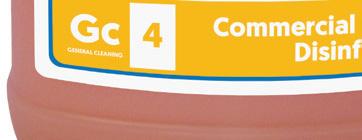










































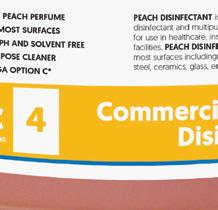






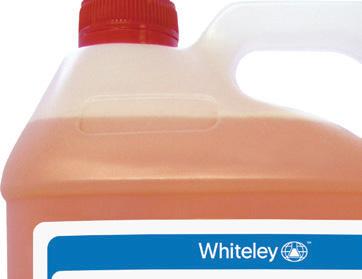



` Lightweight at 5jg
` Reusable 15-litre SMS dust bag
` Disposable 15-litre paper dust bags
` Three-stage filtration + high filtration filter
` Two-year body and motor warranty
RapidClean New Zealand
www.rapidclean.co.nz
Pullman Advance PV900
Exclusively available at Vacspare, the PV900 is a high-powered backpack vacuum designed for maximum user comfort in any commercial setting. This model features a patented gulper advance floor tool that now has ball bearings in the wheels for easy manoeuvrability and a smoother glide over carpets and hard floors. A unique comfort system harness is complete with three height settings and anti-vibration technology. Patented air ventilation systems, turbo suction mode and HEPA13 filtration all contribute to a healthier more hygienic environment.
www.incleanmag.co.nz 45 PRODUCTS
Vascpare
Peach Disinfectant

Peach Disinfectant is a commercial grade disinfectant and multipurpose cleaner designed for use in healthcare, institutional and commercial facilities. Being pH neutral and solvent free, Peach Disinfectant is safe for use on most surfaces including: plastics, metals, stainless steel, ceramics, glass, enamels and painted surfaces. Peach Disinfectant can be used in any area where soiling is a problem, including floors, walls, bench tops, doors, etc. Peach Disinfectant passes TGA option C at 50ml/L water. Peach Disinfectant is available in a 5-litre bottle and has a refillable 500ml trigger spray bottle.
Whiteley Corporation 0800 257 352 www.whiteley.co.nz
Sanitol Jade
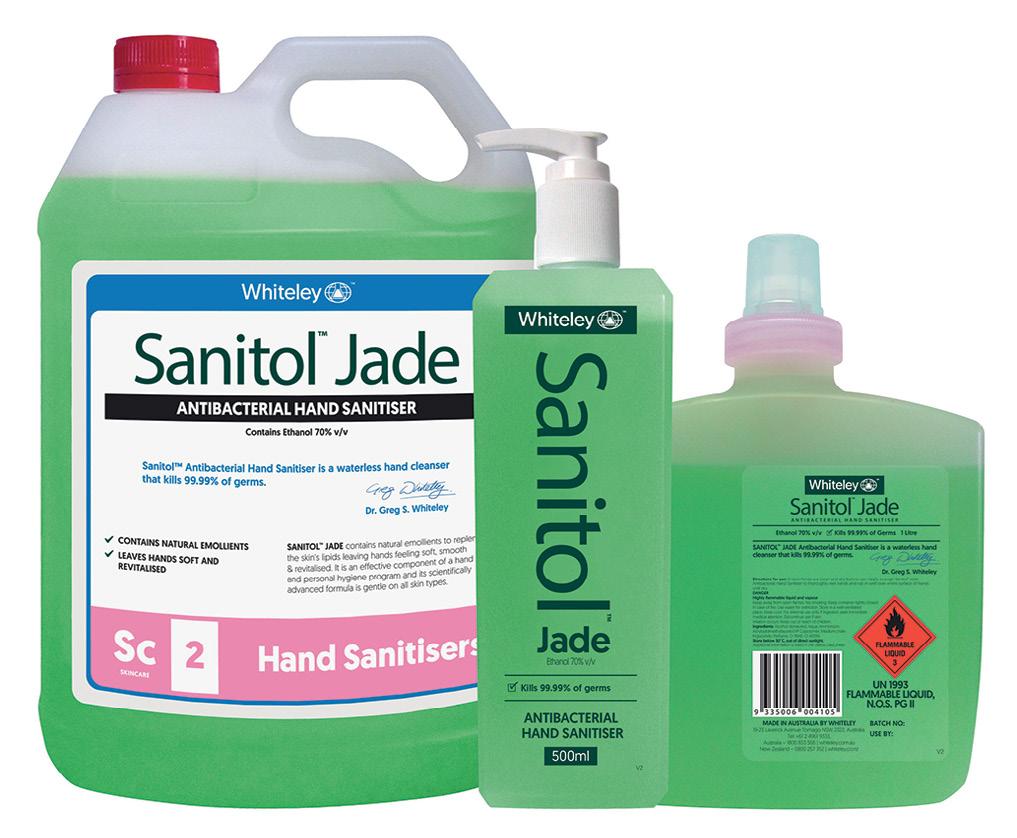
Sanitol Jade is a is a uniquely formulated antibacterial hand sanitiser designed to prevent the spread of harmful germs. Sanitol Jade has a rapidly acting formula that kills 99.99 per cent of germs – protecting you against a range of potentially unsafe microorganisms. Sanitol Jade is an effective component of a personal hygiene program and its scientifically advanced formula is gentle on all skin types. Benefits:
` Contains natural emollients to replenish the skin’s lipids – leaves hands feeling soft, smooth & revitalised
` Natural skin conditioners and light pleasant fragrance – ideal for all ages to use
` A refreshing gel that kills germs without the need for water
Whiteley Corporation 0800 257 352 www.whiteley.co.nz

Florogen Range
Florogen is a specially formulated, alcohol-based, surface and space deodorant. Florogen removes unwanted odours and provides a positive method for increasing hygiene in the immediate area of use. Florogen has a pleasant fragrance and kills 99.9% of bacteria. Florogen is available in 5-litre and 500ml spray bottles.
Benefits:
` Long lasting deodorisation
` Hospital strength odour control
` Five fragrances available: Strawberry, Frangipani, Original, Citrus, Lavender
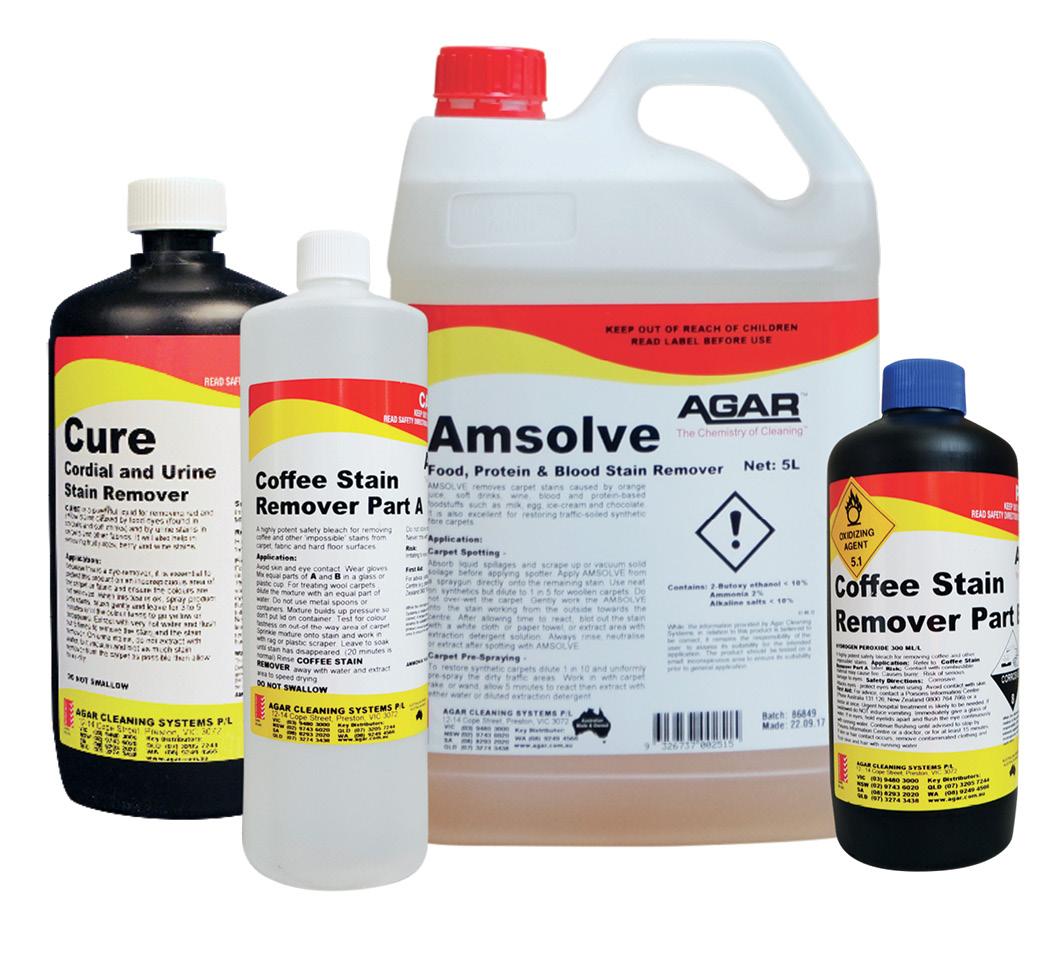
Whiteley Corporation 0800 257 352 www.whiteley.co.nz
Agar Carpet Cleaning Chemicals
The highly effective, specialised carpet cleaning solutions from Agar are trusted globally and offer the best cleaning outcomes for a wide range of carpet soiling and stains. The range includes stain removers, pre-sprays, Hot Water Extraction (HWE) formulations, treatments, and upholstery care products. The superior concentrated formulations have been specifically designed and improved over many years and the high-performance products are field tested and proven for reliable, fast, and brilliant cleans every time. The solutions have been formulated to be gentle on users and there’s a colour coding system to make choosing the right solution to use simpler and safer. Talk to our friendly team to find out more.
Proquip New Zealand www.proquipnz.co.nz
PRODUCTS
46 INCLEAN NEW ZEALAND November 2022
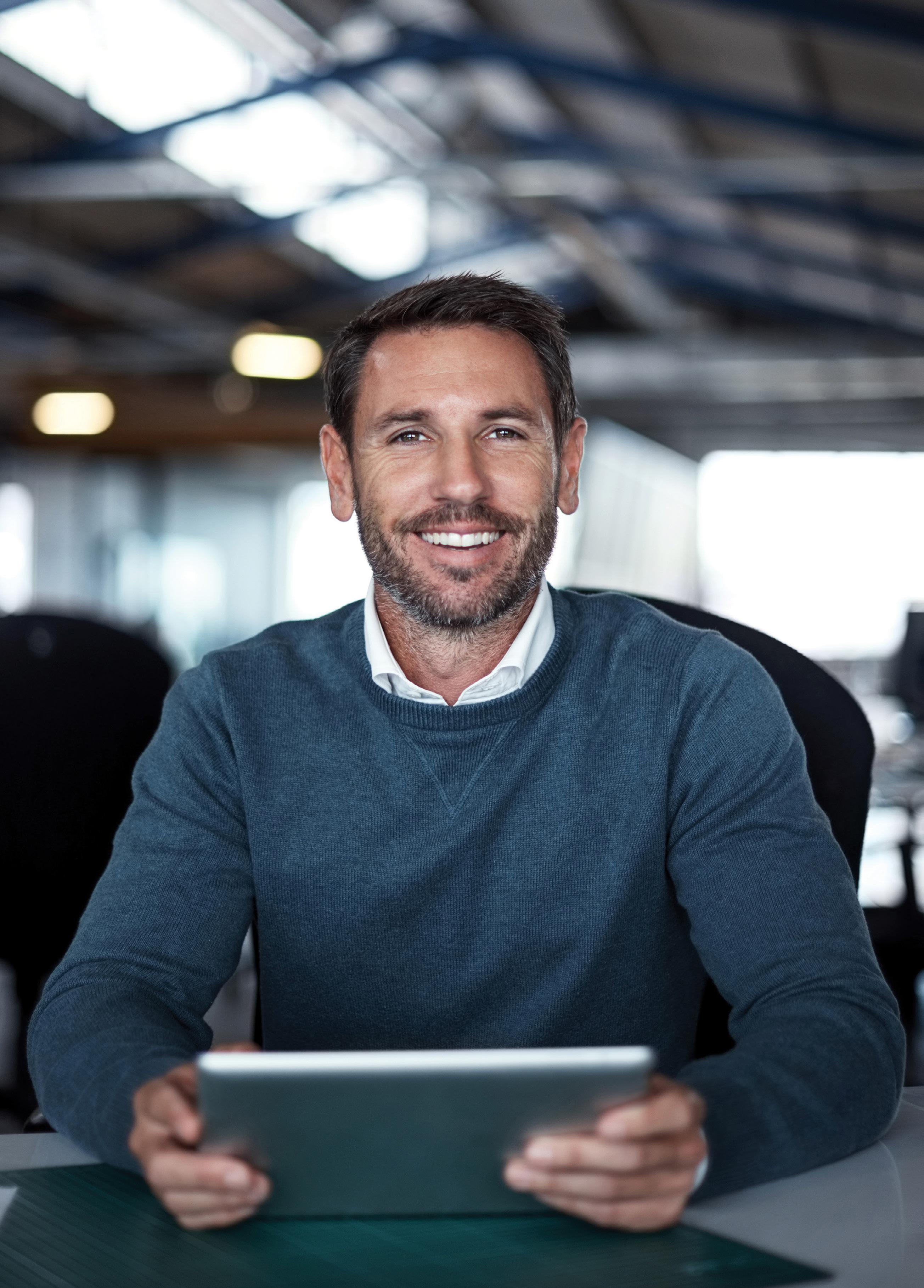
Keep up to date with the latest industry news direct to your inbox Sign up to the weekly newsletter at www.incleanmag.co.nz/register-for-e-news
CLEAN SMARTER
WIRELESS CLEANING
Makita®

LIDAR SENSOR
CAMERA SENSOR
PERFORMANCE
makitasales@makita.co.nz
X2 LXT ® BRUSHLESS SMART ROBO VACUUM
18V
LXT® Robotic Vacuums offer advanced cleaning options via the purpose built app.
with LiDAR sensor, providing a high-resolution 3D view of its surroundings
LXT® Robotic Vacuum builds on its advanced mapping capabilites with a front camera
Equipped
Makita®
Robo Cleaner Pro can clean up
to the size
two
half tennis courts
The
to 600m2 equivalent
of
and a
































































































































































































































































































 Words Cameron Cooper
Words Cameron Cooper


































































